5 Tips for Understanding Nautical Flags & their Meanings
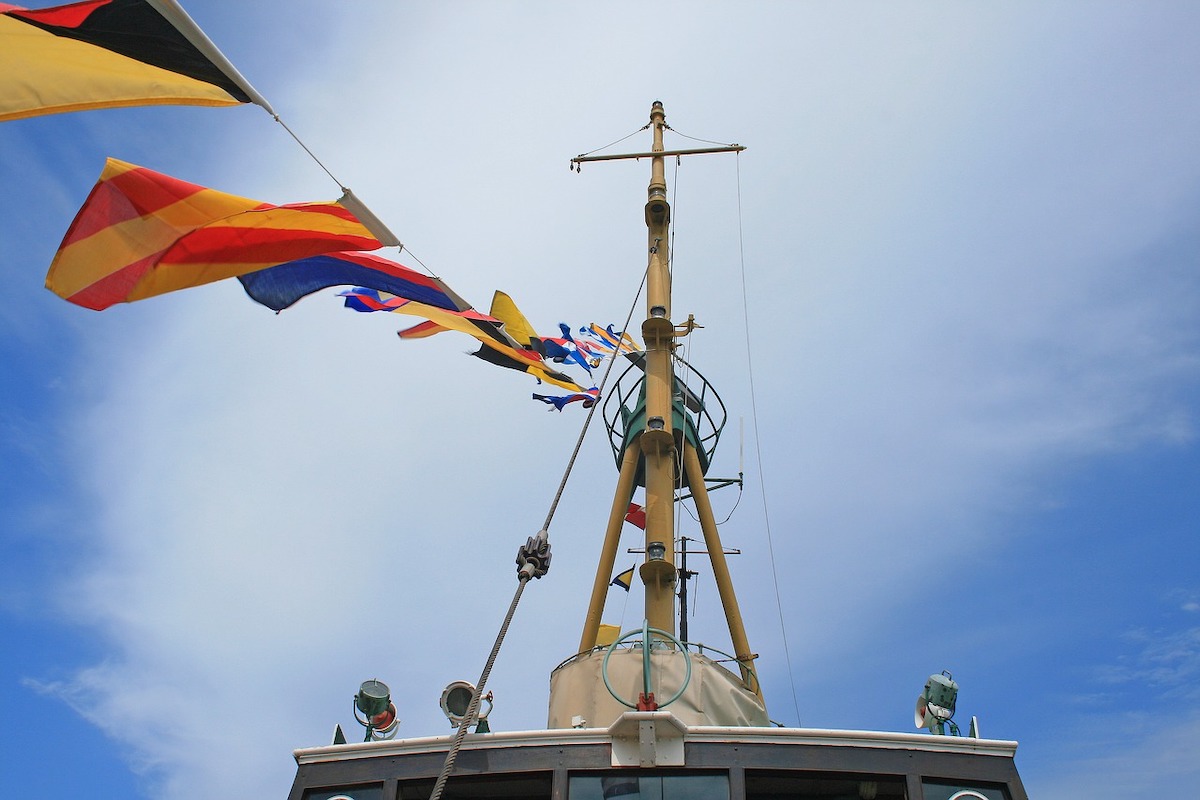
If you’re curious as to the deeper meaning behind these signals, here’s some nautical flags know-how.

1. Shapes and types are important.
Nautical flags mostly take the forms of squares, though you’ll also see pendants, which are triangular with a flat tip. You’ll additionally see what’s called substitutes (alternately called repeaters), which are triangles. Since this is a “flags 101” article, we’ll focus on the squares and pendants. They’re the ones you’re more likely to see in common boating situations.
2. Learn the letters and numbers.
There are 26 square nautical flags, each representing a different letter of the alphabet. More accurately, each represents the international code word connected to the letters of the alphabet, such as Alpha, Bravo, Charlie, Delta, and so on. In addition, there are 10 pendants for the numbers zero through nine. For the numbers 10 and larger, a boat would combine flags.
3. Colors are by choice.
The only colors you’ll find on nautical flags are black, blue, red, yellow, and white. These colors stand out quite well when seen with your own eyes on the horizon or through binoculars. Flags can be a solid color or a combination of colors, too.
4. Solo or combined, nautical flags convey meaning.
Depending on the intended message, boats fly one flag or up to seven flags in a row.
- For example, if you see the A (Alpha) flag , this means “diver down, keep clear.”
- If you see the W (Whiskey) flag , the boat has a medical emergency and needs help.
- The combination of the D (Delta) and V (Victor) flags , meanwhile, means “I’m maneuvering with difficulty and require assistance.”
- The J (Juliet) and L (Lima) flags mean “you’re running the risk of going aground.”
In fact, signals with two nautical flags typically mean some type of distress or maneuvering issue. Three or more flags can include pendants and denote things like points of the compass, geographical signals, names of ships, time and position, as well as latitude and longitude.
5. Flags are sometimes exclusive or secret language.
While boaters around the world use nautical flags to communicate common scenarios, particular situations call for their own language. Race committees combine flags to convey a race is four minutes from start, for example, or that a course has been shortened. The U.S. Navy groups together signals in ways known only to its personnel to communicate with its fellow ships.
Read Next: Basic Boating Etiquette
You Might Also Like:
- How to Navigate a Boat
- Boating Courses, Education & Training
- Safe Boating Guide
- Best Boating Apps: Navigation, Fishing, Weather & More
- The Ultimate Boat Buyer's Guide
Join Our Newsletter!
Get community news, buying bargains, and how-to guides at your fingertips.
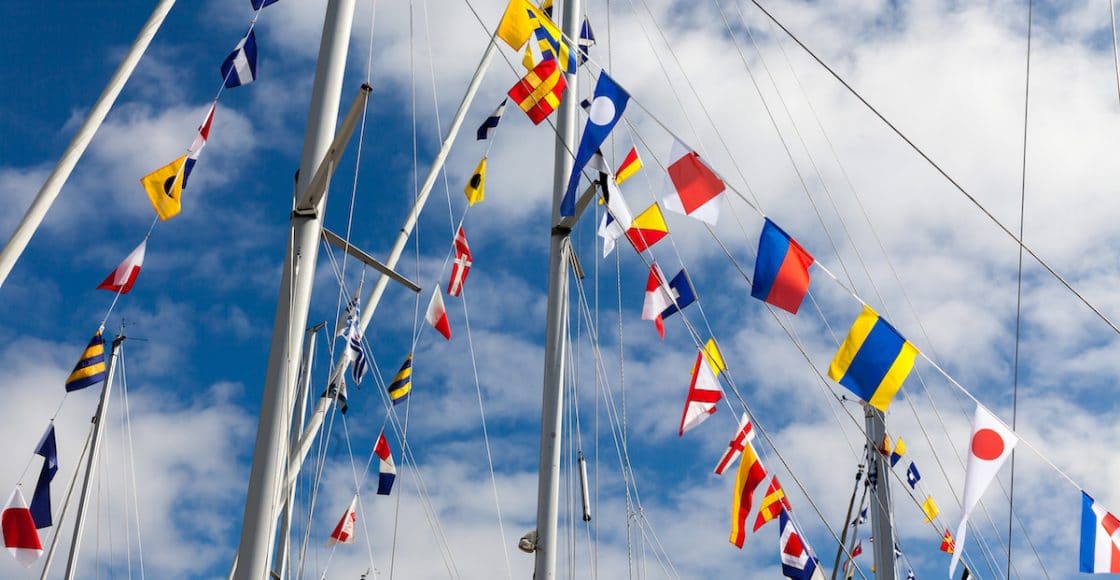
Understanding the Nautical Flags, Sailing Flags, & the Nautical Alphabet

Table of Contents
Last Updated on June 9, 2023 by Boatsetter Team
Just as the marine electronics and lights on a boat help you communicate with your fellow cruisers, nautical flags and sailing flags are a language of sorts, too. They help alert others to maneuvers you’re making, for example, or an emergency. In certain combinations, they warn of bad weather. It all depends upon which flag—or flags—you see.
Here’s how to make sense of the nautical flag alphabet. This way, you understand the situation at hand when you’re next out on the water.
Explore Powerboat & Sailboat Rentals Near You
6 Tips for Identifying Nautical Flags
1. pay attention to the flag’s shape..
Most nautical flags are squares. Additionally, you’ll find some resembling triangles but with flat tips—a.k.a. pendants. These two shapes are the most common.
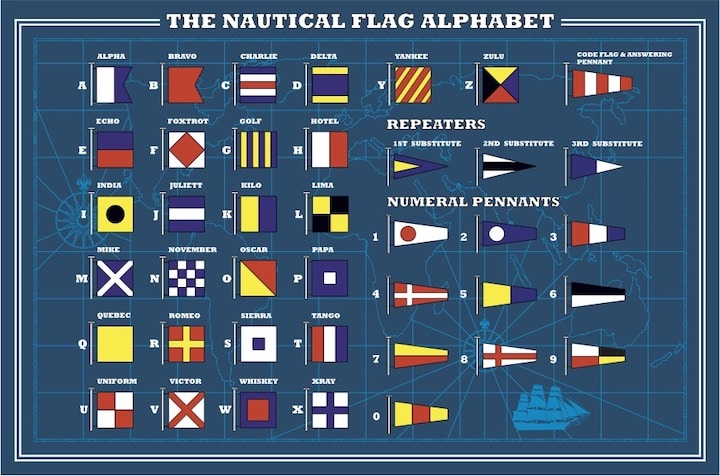
2. Learn the nautical flag alphabet.
Conveniently, for every letter of the alphabet, there’s an equivalent square nautical flag. Well, more accurately, each flag represents international code words like Alpha, Bravo, Charlie, etc., which correspond to alphabetical letters. The full list and their meanings:
- A – Alpha – diver down; keep clear
- B – Bravo – carrying dangerous cargo
- C – Charlie – affirmative (yes)
- D – Delta – keep clear, I am maneuvering with difficulty
- E – Echo – altering course to starboard
- F – Foxtrot – I am disabled, communicate with me
- G – Golf – I want a pilot
- H – Hotel – a pilot is onboard
- I – India – I am altering my course to port
- J – Juliet – vessel on fire, keep clear
- K – Kilo – I want to communicate with you
- L – Lima – stop your vessel instantly, I have something important to communicate
- M – Mike – my vessel is stopped and making no way through the water
- N – November – negative (no)
- O – Oscar – man overboard
- P – Papa – about to sail (when flown in port; at sea, fishing vessels use it to mean their nets are caught on an obstruction)
- Q – Quebec – I request free pratique (clearance to enter port due to no disease onboard)
- R – Romeo – reverse course
- S – Sierra – engines are going astern
- T – Tango – keep clear, I am engaged in trawling (if a fishing vessel; if a naval ship is flying this flag, it means do not pass ahead)
- U – Uniform – you are heading into danger
- V – Victor – I require assistance
- W – Whiskey – I require medical assistance
- X – X-ray – stop your intention
- Y – Yankee – I am dragging anchor
- Z – Zulu – I require a tug
3. Remember that the numbers on nautical flags have meanings, too.
When it comes to numbers, boaters use pendants. Ten different pendants represent the numbers zero through nine. A combination of flags denotes the numbers 10 and up.
4. Consider the color of the flag.
Nautical flags only use five colors:
Not coincidentally, each of these stands out against the sky, easily seen through binoculars or with the naked eye. You might see a solid-color flag or one with a combination of colors. For example, two red pendants means there’s a small-craft advisory.
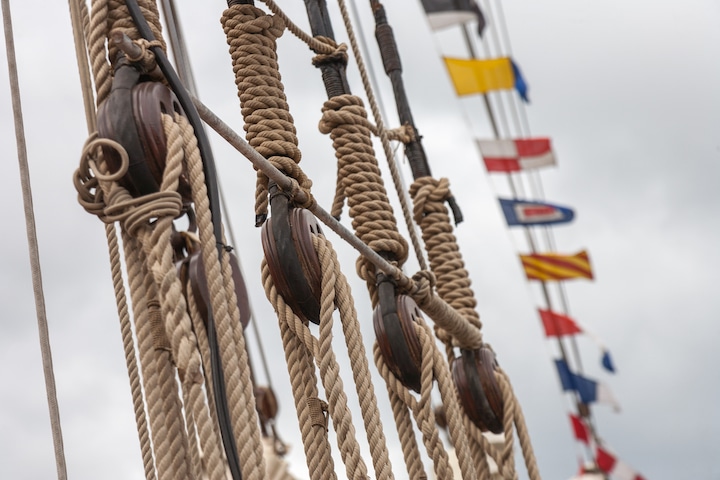
5. Tally the total.
Boats can fly up to seven flags in a row to convey certain messages.
- Solo flags are the previously mentioned international code words (Alpha for diver down, for instance).
- Two nautical flags flown together typically indicate distress or a maneuvering problem. A good example: Oscar and Whiskey flown together mean someone fell overboard and needs medical assistance.
- Three-flag signals can mean the points of the compass, among other things. Four-flag signals are ship names, while five are time and position. Six-flag signals indicate latitude and longitude, while seven mean longitude with more than 100 degrees.
6. Keep in mind that special languages exist.
Sometimes, the nautical flag alphabet is unique to certain situations. Regattas assign different meanings to a few flags, so that racers understand what’s happening. NATO and even the U.S. Navy do, too, with only their personnel knowing the meanings.
Ready to hit the water? Browse local boat rentals near you.

A journalist with more than 30 years’ experience, Diane M. Byrne is the owner of MegayachtNews.com, a daily website educating American superyacht owners, buyers, and their circles of influence about the leading builders, designers, cruising destinations, and more. She founded the website in 2007 as the first, and still the only, American-focused online media outlet exclusively covering this market. It features all-original content, for real stories of real interest.
Diane is additionally one of the most-sought-after journalists for expert editorial coverage and commentary about not only superyachts, but also general boating and yachting. Her byline appears in Boatsetter.com, DiscoverBoating.com, and the magazines Luxury Guide, Ocean, Yachting, and Yachts International.
Additionally, Diane is the Chair of the U.S. Superyacht Association, having been on the Board of Directors since 2015. Outside of yachting, she’s a trustee of Sempre Avanti, a non-profit resource supporting Italian and Italian-American individuals, businesses, and organizations in the United States and Italy.
Browse by experience

Explore articles
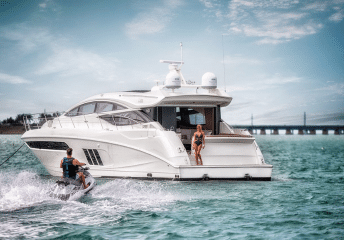
Impress Your Friends with a Party on the Water
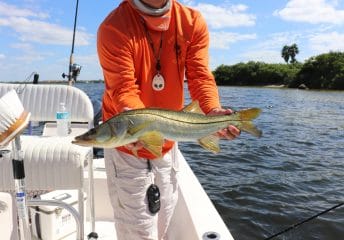
Fishing Report from Tampa Bay - Late October Morning // Ebb and Flow Charters
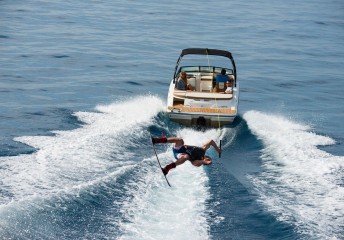
Your Guide to Purchasing the Perfect Wakeboard Boat

The Best Boat Up Restaurants & Bars in Chicago

Racing Signals: Sailing Flag Meanings

Where other competitions have umpires and referees right next to the players, sailing race committees have to rely on flags to communicate with sailors.
In this article, we are going to explain the meanings of all the flags used at regattas to communicate with sailors. The flags can give information about starting procedures, course information, and on-the-water judging, so a basic understanding is a crucial part of general seamanship.
While nautical flags all have defined meanings in a historical context, they have very specific meanings in the context of racing competition. For instance, in the general nautical world, the Z-flag means that you are in distress and are in need of a tow or relief from a tug boat. At a regatta, the race committee may fly the Z-flag to indicate an additional penalty for any boat that has crossed the line early. Moreover, even though there are certain flags that have well-defined roles, race committees may stipulate additional meanings or introduce new flags via an announcement in the sailing instructions for the event, so we will cover some of these more common changes as well. We will break down the meanings into the various categories of usage.
A secret that I have learned over many years of regattas at every level from proverbial ‘beer-can’ races to national championships is that, as well as both you and the race committee can recite the racing flag rules on land, someone is always going to make a mistake or misunderstand these symbols. That is why I will be going through the official flag meanings and rules from the Racing Rules of Sailing for 2021-2024 to clarify any questions that you might have when the race committee flies a flag that hasn’t been seen since we used Clipper Ships to cross the oceans. Hopefully this article will help break down all the most common signals so that when your friend turns to you and asks ‘is that the flag that tells us it's time to go in,’ you’ll be able to help out!
Table of contents
Flags at the Start
The start of a race is often the most confusing part of a regatta and is where the most flags must be used. We will be going over the rules for the flags at a basic 5-minute start. These can be modified for 3-minute dinghy starts, 5-minute match race starts, 6-minute Olympic starts, or 10-minute big boat starts, but the same logic applies.
A few flags are crucial to set everything up on the starting line prior to the starting sequence.

To begin, the race committee must have an Orange Flag visibly displayed, as this demarks the exact location on the boat from which the line is called. If there is a pin boat, they will often fly an Orange Flag as well, but if it is just a buoy, then the buoy serves as the other end of the line.

Next, the RC will additionally fly the L Flag if they are ready for competitors to check-in at the beginning of the race day. This helps them confirm that everyone is sailing under the correct sail number, which is often a logistical nightmare. They will blow one horn when raising this flag. If this flag is raised at any point later in the day, it is meant to tell competitors to come by the committee boat again.

Finally, the AP Flag is a general purpose postponement flag. The race committee may raise this on land to indicate that the harbor start has been delayed or on the water to indicate that there will be a delay in the starts. While there are other flags that are used for abandonment situations, particularly the N Flag, the AP is commonly used in informal situations. Two sounds accompany the raising of the AP, and it can be said that competitors are ‘under AP’ until it is dropped, along with one sound. If it is dropped on land, competitors may immediately launch. If it is dropped on the water, the next start may begin in as little as one minute.

The final note with the AP Flag is that the race committee may indicate the end of racing for the day by flying ‘AP over A.’ Again, the AP could technically be replaced with the blue and white checkerboarded N Flag, but the two serve very similar purposes at most levels.
Starting Flags

Once the race committee is set up and everyone is ready to go sailing, the next task is to get the right fleets to the starting line for their start. At the warning signal, one loud horn that indicates that the 5-minute countdown to the start has begun, the race committee will raise some type of Class Flag that indicates which type of boat will be starting. Above we have the different class flags for the different competition rigs for the ILCA-Dinghy, formerly known as the Laser, which would be raised to indicate which rig is starting.

This is a convention even if there is only one class on the water. Sometimes this is replaced with raising the Orange Flag itself, or some other flag as laid out in the sailing instructions. Often classes have been assigned a numeral pennant, of which 1-4 are displayed above, in place of the highly specific Class Flags. Still, some flag of this nature goes up at 5-minutes and remains up until go, at which point it is dropped.

At 4-minutes, the RC will sound another horn, known as the preparatory signal, and raise some combination of the above flags.
The P Flag is always required to go up, and it is simply the ‘Prep Flag,’ which signals to the racers that they need to get serious about the race. Once the P Flag is raised, all the right-of-way rules that apply during the start switch on and racers, particularly in team and match racing, are allowed to begin tactically engaging with each other (though in team racing this would happen at minute 2 of the 3-minute start). Moreover, racers can talk with their coaches until the prep signal, and race committees may alter the course up until this moment. Afterwards, all coaching is banned and all course changes on the current leg are not allowed. This belies the fact that a 5-minute starting sequence is actually a 4-minute sequence with a warning signal at 5-minutes, but that is a purely semantic detail.
Depending on how rowdy the competitors are, the race committee may raise any combination of the I, Z, U, or Black Flags. Each of these flags deals with boats that start ‘on-course side’ (OCS), essentially a false start for sailing. If any of these flags is raised, a boat is not allowed to be anywhere within the triangle formed by the starting line and the first mark of the course after the 1-minute signal during the start. These flags essentially help the RC ensure that they can get off a clean start and ensure that they can identify any boats that are OCS at go. When they are flown, the following penalties are added beyond requiring a boat to clear itself by dipping back under the line:
- I Flag: Conventionally referred to as the ‘one-minute rule,’ this requires that any boat over the line after a minute also has to sail around an end of the line in order to start the race fairly. This punishes a boat for being over by potentially making it a little harder to clear themselves if they are over on a large line.
- Z Flag: Often flown in combination with the I Flag, this flag adds that any boat that is OCS will get a 20% penalty on top of their score in that race, regardless of whether they clear themselves or not. This further hurts any boat that is ‘pushing the line’ by ensuring that even if they manage to clear themselves and come back, they will still see an impact on their scoreline that is equivalent to immediately being passed by 20% of the fleet.
- U Flag: Now we’re getting into harsh territory. When the RC is really trying to brush the fleet back off the plate, this flag immediately disqualifies a boat that is over after a minute with no course for redress. If these boats are identified, they tend to be told to stop sailing the race by a notice board at the top mark.
- Black Flag: The black flag serves a very similar purpose to the U Flag, except it is a step harsher. It disqualifies you after a minute and even prevents you from sailing in a restart of the race or a race abandoned halfway through.
The I Flag is by far the most common flag, and is often effective at keeping boats from being over. The U Flag rule was introduced in 2013 as an option and formally codified in the Racing Rules in 2017 and is massively more popular than the Black Flag, which is considered overly punitive. In particular, when many sailors are over in a Black Flag start, such that the RC cannot determine who was over, they are forced to make unfair decisions that carry over to the restart, so the U is now almost universally used in its place. Additionally, as the U has become more popular, people tend to shy away from the Z flag, which is considered cumbersome for scorers and confusing to sailors.
In general, while these flags are supposed to be raised in conjunction with the P Flag, often the RC will only raise the most punitive of the flags, as any of them can essentially be considered as a prep flag.
As the starting sequence continues, any prep flag(s) raised must be lowered at the 1-minute signal. The class flag is then lowered at go, leading to the next category of flags: Recall Flags
Recall Flags
After the pain of raising and lowering all those start flags, the RC then has three possible jobs. If the start is clean, they shout ‘All Clear!’ and can then relax until they have to start another race or record finishes for the race in progress. Unfortunately, this is often not the case, as they likely will need to ‘recall’ certain competitors for being ‘OCS,’ i.e. false starting. They have two choices here.

If only a few, easily-identifiable boats have started early, the RC will raise the X Flag along with a single sound in what is referred to as an individual recall. This indicates to the boats on the course that there are some competitors who are currently OCS and must clear themselves. If the I Flag had been flown for the start, competitors have to round an end; if not, they can just dip back behind the starting line and restart from there.
While the X is suitable on its own to inform a boat that it has been called over, it is an oft practiced courtesy for the RC to hail an OCS boat’s sail number over a megaphone, a radio, or other transmission device. The X Flag is dropped when all OCS boats have cleared themselves or after 4 minutes from go, whichever comes first.

If more boats than can be easily identified are called over, the RC can blow two horns and fly the First Substitute Flag, indicating a general recall. In this case, the race is fully reset and the committee will initiate another entire starting sequence for that fleet. After a general recall, the RC will often, but not always employ the next level of penalty flag for the restart in an attempt to get the race off cleanly.
Sometimes, as in college sailing or as stipulated by other sailing instructions, any general recall immediately implies the I Flag for the next sequence if it had not been flown previously. As such, the RC does not necessarily have to fly the I if it is unavailable. Still, such stipulations are almost always written out explicitly for a given event and are often accompanied by a verbal announcement as a courtesy.
Still, outside some usages of the AP or N Flags to abandon or delay starts already in sequence, these are all the flags that deal with general housekeeping and the starting sequence.
While Underway
While the starting flags are by far the most complicated of the flag rules, there are still other flags to keep track of while racing. The first among these are...
Course Change Flags
Although course changes are relatively rare, race committees often pull them out when conditions change substantially during races or if there has been a problem with one of the marks.

When wind or time constraints require, the race committee may send an official to any mark of the course that no boat has yet rounded and have it raise the S Flag along with two sounds. This indicates that the fleet shall finish at that mark, cutting off the race earlier than written in the sailing instructions.

In the case of any other change to the course, such as a minor adjustment to the angle or distance of an upcoming leg, a race committee boat will go to the preceding mark and raise the C Flag along with repeated sounds.
This is sometimes accompanied by a Red Square or a Green Triangle to indicate that the mark has been moved to port or starboard respectively. Although during less formal events, you can change the positions of any marks so long as there are no competitors currently sailing on that leg of the course, it is considered poor form if at all possible to inform competitors, particularly in longer races. Sailors make decisions based on the position of the marks, and if this has been changed without them noticing, that can drastically affect the outcomes of strategic decisions, so in large competitions the C Flag is a must.

If, meanwhile, something odd has happened to a mark of the course, any official boat may fly the M Flag with repeated signals. This serves to inform the competitors that they have become a replacement for the missing mark. This is relatively uncommon, but anchors do occasionally snap on marks, so it is always good to have a support boat with the M if possible.

Finally, as mentioned before, if conditions have deteriorated to the point that a race is considered no longer possible, due to lack of wind, fear of foul weather, or some form of interference -- I’ve seen it happen because cruise ships wanted to pass through a dinghy course, and you don’t say no to them -- the race committee may abandon the race using the N Flag. Still, this flag is relatively rare as you will often see the AP in its place for convenience, as they are functionally similar.
Miscellaneous Flags
While we have covered the bulk of the flags necessary for racing at any level, there are a few more flags from across different disciplines and classes that are worth mentioning, if only to let you in on these quirky parts of the racing world! This starts with what one could reasonably call…
The Cheating Flag

Calling the O Flag the cheating flag is certainly a bit of a misnomer. The O Flag does, however, suspend Rule 42 of the Racing Rules of Sailing. Rule 42 is particularly notorious, as it bans pumping, rocking, ooching, sculling, and excessive maneuvering, all of which are methods to make your boat go substantially faster. While Rule 42 is worth an article in and of itself, the larger point is that it is meant to keep anyone from gaining an unfair advantage over their competitors.
Certain competitive classes, however, including the Olympic class 470s and Finns and many of the new foiling fleets, allow competitors to ignore Rule 42 in certain conditions, typically in heavy breezes that are referred to as ‘planing’ conditions. There are differences across the classes, but whenever it is allowed and the RC flies the O Flag, Rule 42 is switched off and competitors can ooch, pump, rock, and tack their boats all around the racecourse. This allows for a much more physical style of sailing and is a rule that many different classes and sectors of sailing are beginning to consider.

If conditions no longer meet the threshold for that class’s rules regarding suspension of Rule 42, an official boat will raise the R Flag at some point during the race. They can only do so at a mark of the course so that it is fair to all the competitors throughout the fleet. This is relatively rare, and is normally done between races, but is still a key part of the O Flag rule.
Judge and Umpire Flags
On the topic of Rule 42, there are certain fouls in sailing that can be actively enforced on the water by judges or umpires, depending on the context.
Rule 42 is enforced by judges with a Yellow Flag, which they will point at an offending boat along with a sound signal and a direct sail number hail. That boat may clear themselves from their first Yellow Flag by taking their two-turn penalty, but, unless otherwise noted in the sailing instructions, any subsequent violation can entail disqualification.
Finally, certain levels of modern match and team racing, with the addition of high-performance racing like SailGP, have full on-the-water umpires who actively follow the racing to make calls on fouls and other plays. While this is not the spot to go through the intricacies of team and match race calls, the basic gist is as follows.
In any interaction, any boat involved in the race may call in the umpires if they believe that their opponent has fouled them. If the opponent clears themselves quickly, essentially admitting fault, the umpires will not get involved. If no boats clear themselves, the umpire has to make a call on whether there has been a foul. If they determine that the maneuvers were clean, they will make one sound and fly a Green Flag, thus exonerating all boats in the interaction. If they determine there was a foul, they will fly a Red Flag with a singular sound and hail the offending boat.
Beyond that, if a boat is found to have broken a rule not related to an interaction, the umpires may come in and fly the Red Flag without being directly invited into the situation. Further, if a boat is found to be in violation of sportsmanship or refuses to take a penalty as assessed by an umpire, the umpire may fly a Black Flag, disqualifying them from the race.
While there are differences at each event and in each discipline, these general guidelines are followed in most umpired races, with specific flags used at various events, generally depending on availability.
With that, we have made it from land, through the start, a few general recalls, all the way to umpire flags! I hope this has helped you get a grasp of the various flags used across sailing. While this has not scratched the specifics of the various alterations made for kiteboards and windsurfers, nor some of the annoyances of protest flags and more, we have gone through the bulk of regularly used race committee and umpire signals.
The ‘Wear Your Life Jacket!’ Flag

Finally, we have a safety flag. At big boat regattas, the race committee may, if it chooses, fly the Y Flag at any point prior to a start to inform competitors that they must wear personal floatation devices, which is not always strictly necessary.
The Most Important Flag
While I wish I could tell you that everyone uses their flags properly and accompanies them with the proper timing and sound signals, that is far from the truth. Everyone’s flag set is slightly incomplete or out of date, and invariably there is going to be a miscommunication somewhere, where the race committee forgets to put the I Flag up but really should have; I’ve certainly done that a time or two. Still, there’s nothing quite like being on the water, so, despite the endless mutual griping between racers and their race committees, hopefully everyone comes back to shore flying the ‘Happy Flag.’
Happy sailing!
Related Articles
Gabriel Hannon
I have been sailing since I was 7 years old. Since then I've been a US sailing certified instructor for over 8 years, raced at every level of one-design and college sailing in fleet, team, and match racing, and love sharing my knowledge of sailing with others!
by this author
Most Recent

What Does "Sailing By The Lee" Mean?
Daniel Wade
October 3, 2023

The Best Sailing Schools And Programs: Reviews & Ratings
September 26, 2023
Important Legal Info
Lifeofsailing.com is a participant in the Amazon Services LLC Associates Program, an affiliate advertising program designed to provide a means for sites to earn advertising fees by advertising and linking to Amazon. This site also participates in other affiliate programs and is compensated for referring traffic and business to these companies.
Similar Posts

How To Choose The Right Sailing Instructor
August 16, 2023

Basics Of Sailboat Racing Explained
May 29, 2023

Cost To Sail Around The World
May 16, 2023
Popular Posts

Best Liveaboard Catamaran Sailboats
December 28, 2023

Can a Novice Sail Around the World?
Elizabeth O'Malley
June 15, 2022

4 Best Electric Outboard Motors

How Long Did It Take The Vikings To Sail To England?

10 Best Sailboat Brands (And Why)
December 20, 2023

7 Best Places To Liveaboard A Sailboat
Get the best sailing content.
Top Rated Posts
© 2024 Life of Sailing Email: [email protected] Address: 11816 Inwood Rd #3024 Dallas, TX 75244 Disclaimer Privacy Policy

Sailboat Racing Flags and Signals
Are you ready to hit the open water and experience the exhilarating world of sailboat racing? Before you set sail, it’s crucial to understand the meaning behind the various flags and signals used during races . In this article, we’ll dive into the International Code of Signals, explore preparatory, course, protest, abandonment, penalty, safety, and emergency signals.
Get ready to navigate the racing scene with confidence and sail towards victory!
Key Takeaways:
- The International Code of Signals consists of 26 flags and 10 numeral pennants , which are used for safety and communication on the water.
- Preparatory flags and signals such as the ‘P’ flag, ‘I’ flag, ‘S’ flag, and ‘X’ flag are crucial for sailors to understand and respond to, as they indicate important instructions and changes in the race .
- Course and mark signals provide information about the direction to sail and the marks themselves, helping sailors navigate the racecourse effectively and make informed decisions.
- Protest flags and signals, including the red flag with a white cross, blue flag, yellow flag, and red flag, are important for ensuring fair competition and resolving disputes between boats.
Table of Contents
The International Code of Signals
You should learn the International Code of Signals, as it consists of 26 flags and 10 numeral pennants that can convey important messages while sailing. These signals are essential for maintaining safety and communication on the water. By familiarizing yourself with this code, you can ensure that you’re prepared for any situation that may arise while sailing.
The International Code of Signals is a universal system used by sailors around the world . Its simplicity and effectiveness make it a valuable tool for communication at sea. Each flag and pennant represents a specific message or instruction , allowing sailors to convey important information without relying on verbal communication.
Learning the International Code of Signals is particularly important for those who desire freedom on the water. By understanding and using these signals, you can communicate with other boats, request assistance, or inform others of potential dangers. This knowledge empowers you to navigate the open seas confidently and independently.
In addition to enhancing your safety, knowing the International Code of Signals also allows you to fully immerse yourself in the sailing community. It’s a language shared by sailors worldwide, connecting you to a global network of adventurers who share your love for the sea.
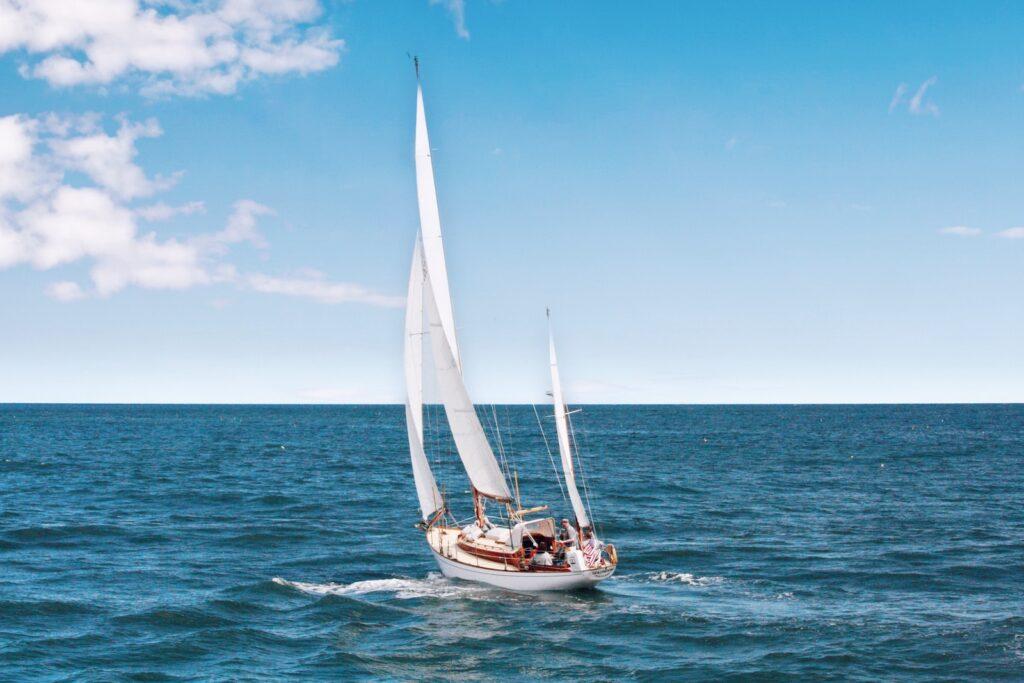
Preparatory Flags and Signals
Make sure to brush up on the meaning of the preparatory flags and signals before your next sail, as they can indicate important information about the race or event. These flags and signals are essential for every sailor who desires the freedom to compete in sailboat racing.
When you see the preparatory flag ‘P,’ it signals that the race is about to start, and you should be ready to go . Another important signal is the ‘I’ flag, which indicates a change in the starting line . Pay attention to this flag, as it could affect your strategy and give you a competitive advantage.
During the race, you may encounter the ‘S’ flag, which means you must take a penalty for a rule infringement . Don’t ignore this flag, as it could cost you valuable time and position. Additionally, the ‘X’ flag indicates that the race has been abandoned or postponed . If you see this flag, be prepared to follow the instructions given by the race committee.
Understanding and responding to these preparatory flags and signals is crucial for any sailor who values their freedom to compete in sailboat racing. So, take the time to familiarize yourself with them and be ready to navigate the racecourse with confidence and skill.
Course and Mark Signals
When approaching a mark, be sure to keep an eye out for the appropriate course and mark signals to navigate the racecourse effectively. These signals are crucial for your success as a sailor. Freedom is at the core of sailboat racing, and understanding these signals will give you the freedom to make informed decisions on the water.
As you approach a mark, look for the course signal displayed by the race committee . This signal indicates the direction you need to sail after rounding the mark. It could be a simple arrow pointing left or right, or it may consist of multiple arrows indicating a more complex course. Pay attention to this signal to ensure you take the correct path and stay on course.
In addition to the course signal, keep an eye out for mark signals . These signals provide important information about the mark itself. They can indicate a change in the mark’s position, a change in the rounding direction, or even a change in the mark itself . Understanding these signals will help you anticipate any changes in the racecourse and adjust your strategy accordingly.
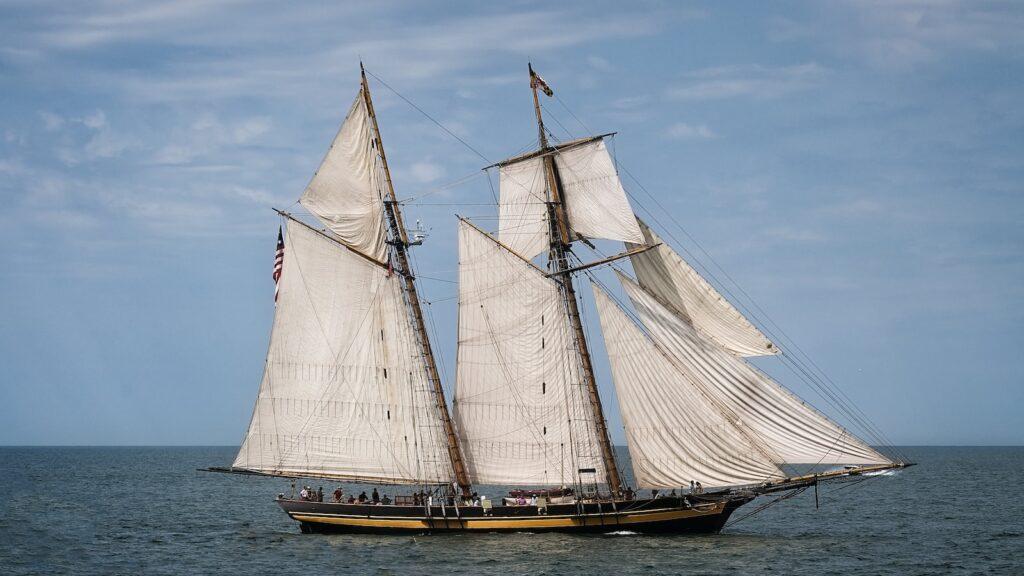
Protest Flags and Signals
When you see a protest flag in sailboat racing, it’s important to understand its meaning. The most common protest flag is a red flag with a white cross, indicating that a boat is protesting another boat for a rule violation.
If you find yourself in a protest situation, it’s crucial to know how to resolve it properly to ensure fair competition.
Meaning of Protest Flags
You should familiarize yourself with the meaning of protest flags before participating in sailboat racing. Understanding these flags is essential to ensure fair competition and maintain the freedom that racing represents.
Here are three important protest flags and their meanings:
- Blue Flag : This flag indicates that a boat intends to protest another boat for breaking a rule. It’s important to keep a close eye on this flag, as it signifies a potential dispute between competitors.
- Yellow Flag : When this flag is displayed, it means that a protest hearing is being held. This flag warns all participants to be cautious and respectful during the hearing process.
- Red Flag : The red flag is raised when a protest has been withdrawn. It signifies that the dispute has been resolved or abandoned.
Common Protest Signal
Don’t underestimate the significance of familiarizing yourself with the common protest signal during sailboat racing. It’s crucial to understand this signal as it can greatly impact your race and the freedom you desire on the open water.
When you see a boat raising a protest flag, typically a red flag, it means that they believe another boat has violated a racing rule. This signal signifies their intention to file a protest against the other boat’s actions.
As a sailor, knowing this signal allows you to be proactive in avoiding potential conflicts and ensuring fair competition. By being aware of the common protest signal, you can navigate the racecourse with confidence, knowing that you’re respecting the rules and upholding the freedom that sailboat racing represents.
Resolving Protest Situations
To effectively resolve protest situations during sailboat racing, it’s important that you remain calm and cooperate with the race officials. Remember, your freedom to enjoy the race depends on your ability to handle these situations with grace and respect.
Here are three key points to keep in mind:
- Communicate clearly: When presenting your protest, make sure your message is concise and easily understood. Use simple language and avoid any unnecessary aggression or hostility.
- Follow procedures: Familiarize yourself with the rules and regulations of the race. Understand the proper steps to take when filing a protest and be prepared to provide any evidence or witnesses that support your case.
- Be open to compromise: Sometimes, finding a middle ground is the best way to resolve a protest situation. Listen to the other party’s perspective and be willing to negotiate a solution that’s fair for everyone involved.
Abandonment Flags and Signals
Grab the binoculars and look for any abandonment flags or signals on nearby boats. As a sailor who desires freedom, you understand the importance of being aware of potential dangers on the water. Abandonment flags and signals are crucial in ensuring the safety of all sailors. These flags and signals indicate that a boat or its crew may require assistance or are in need of immediate rescue. By spotting these flags or signals, you can take action and provide the necessary help, ensuring that everyone can continue enjoying the freedom of sailing.
To help you better understand the various abandonment flags and signals, here is a table highlighting some of the most commonly used ones:
| Flag/Signal | Meaning | Emotional Response |
|---|---|---|
| Red flag | Boat is abandoned or crew is in distress | Concern, empathy |
| Orange smoke signal | Requesting immediate assistance | Urgency, alarm |
| Horn blasts | Distress signal | Attention, urgency |
Penalty Flags and Signals
Keep an eye out for any penalty flags or signals, as they can indicate rule violations and affect the outcome of the race. In sailboat racing, it’s crucial to understand the meaning behind these flags and signals to ensure fair competition and maintain the spirit of freedom on the water. Here are three key points to consider:
- Penalty flags: These flags are raised by race officials to indicate a rule violation by a boat. The flags come in different colors, such as yellow or blue, and are typically displayed alongside a number, representing the specific rule broken. Be vigilant in spotting these flags, as they can result in time penalties or disqualification.
- Signals from other boats: Pay attention to the actions of other boats around you. If a competitor raises a flag or makes a specific hand signal, it could be a warning that you have violated a rule. Keep an open mind and be ready to adjust your tactics to avoid penalties.
- Communication with race officials: If you have any doubts or concerns about a potential rule violation, don’t hesitate to contact the race committee. They’re there to ensure fairness and resolve any disputes that arise during the race. Maintain a respectful and open line of communication to uphold the principles of freedom and fair play.
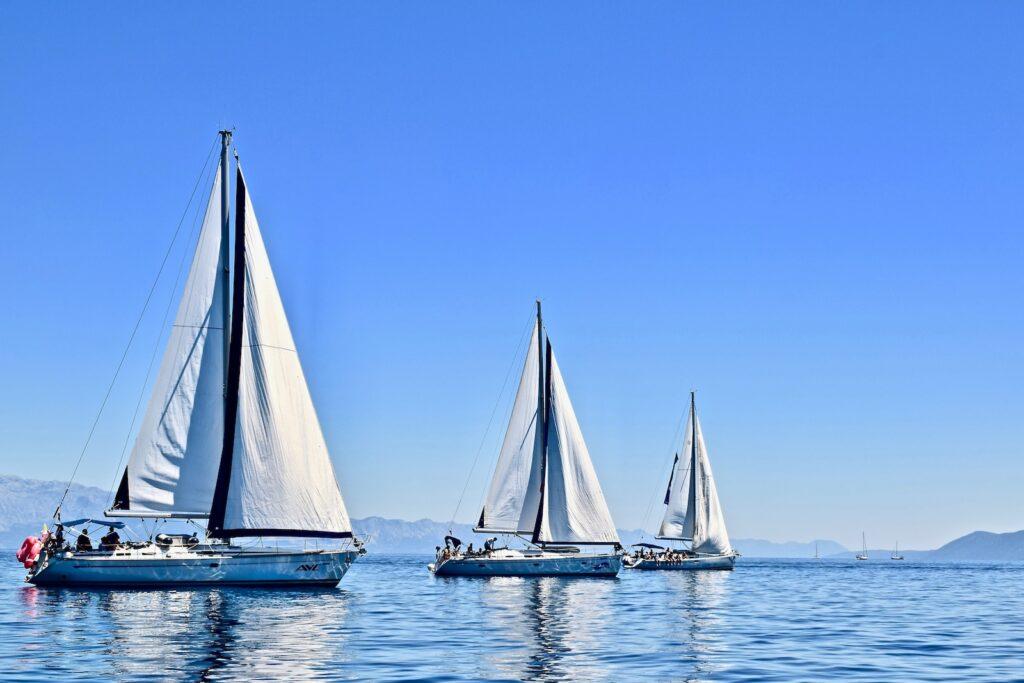
Safety and Emergency Signals
If you encounter any safety or emergency signals during the race, please follow the instructions provided and ensure the well-being of yourself and others. Your safety is of utmost importance, and it is crucial to understand the meaning behind these signals. To help you navigate the race course, here is a table outlining some common safety and emergency signals you may encounter:
| Signal | Meaning | Action Required |
|---|---|---|
| Red Flare | Emergency situation | Stop racing and await further instructions |
| Blue and White Checkered Flag | Abandon race | Return to the starting line |
| Orange Flag | Man overboard | Proceed with caution and assist if possible |
So, now you know the various sailboat racing flags and signals used in competitions. The International Code of Signals provides a standardized system for communication on the water.
From preparatory flags to protest flags, each signal plays a vital role in ensuring fair and safe races. Understanding these signals is crucial for all sailors and race officials.
By following the correct flags and signals, participants can navigate the racecourse effectively and respond appropriately to any emergencies or penalties that may arise.
Related posts:
Leave a Reply Cancel reply
Your email address will not be published. Required fields are marked *
Save my name, email, and website in this browser for the next time I comment.
FREE Shipping Available Orders $75+*
- Call us: 800-858-8776
- Sign In & Register
- Gift Certificates
- Recently Viewed
Your 2024 Guide to Nautical Flag Etiquette
Ever wonder why there are so many boat flags ? How do the sailors know which flag to put first and when? Nautical flag etiquette is an essential part of sailing. The seven most common types of boat flags are Skin Diver flags , Storm Warning flags , Coast Guard boat flags , US Jack flags , Maritime flags and Pennants, Yacht Ensign & Officer flags , and most importantly the International Code Signal flags .
Code signal flags and are frequently used by boats to send messages to other boats. They are made with a sequence of twenty-six square flags that represent a letter of the nautical alphabet. Ten numbered flags, one answering pendant, and three repeaters also form part of the nautical flag sequence.
As with most yesteryear traditions, the popularity of boat flags as a common communication tool is slowly reducing with the introduction of technology. This does not mean that we should discard this sacred tradition.
The world of nautical flags is broad, and we cannot possibly cover them all in this article. Navies, yachts and fishing boats have variations in the meaning of some flags.
While the need for nautical flags might be dwindling in the boating world, they are still pleasing to the eye. Learning when to use nautical flags and how to use them is a skill every sailor and thalassophile should have. Not only is it essential for safety reasons, but boat flags can also a lot of fun. Take a gander at our fun maritime flags and pennants !
Word of the Day: A thalassophile is someone that loves the sea!
This article will teach you the hows and whens of nautical flag etiquette. We will also provide you with a glossary of terms because, let's face it, some boating terms are pretty confusing even for a seasoned sailor.
So put your best sailor's cap on and join us on this great sea signal voyage.
What is Nautical Flag Etiquette?
Glossary of flag terms, flag courtesies.
As silly as it might seem, boat flag etiquette is crucial. In a worst-case scenario, it could mean the difference between life and death. Generally speaking, the nautical flag etiquette is a combination of years of maritime tradition and laws that help boats communicate messages to each other.
Different countries have varying legal requirements that should be observed for boats that enter and leave their waters or ports. So it is helpful to be mindful of sailing the vessel’s legal obligation for various countries. No one likes to pay a fine for something as simple as forgetting or putting up the wrong flag signal.
As we have stated before, the world of boating is vast and sometimes confusing. The terminology used is pretty unique. The key to understanding nautical etiquette is to know what everyone is talking about first.
Even professional sailors don't always get it right. So to help you brush up on your boating terms, we've put together this glossary with definitions. We hope this will help you to understand the nautical phrases that we will use in this article.
ABAFT - refers to the rear end or stern of a ship
AFT – means towards stern of the boat (the back of the boat)
ASTERN – it means to go towards the back of the boat
BOW - refers to the front of the ship
BUTT DIAMETER - is the width of the bottom of the flagpole.
CANTON - the rectangular part of a flag, usually at the top hoist corner of a flag, which occupies about a quarter of the total surface area of the flag
CLOSE UP - it means that the flags are now fully hoisted
COLORS - refers to the raising and taking down of the flags at 8:00 am and at sunset, respectively
COURTESY FLAG - is the national flag of the country that a boat is entering. Ex: Boats entering the United States would display an American flag as a courtesy flag.
DIP - means to lower a flag by turning it forward from an upright position to 45° or horizontal as a sign of deference or respect
ENSIGN - means a flag showing nationality of the boat, i.e. the country where the boat is registered. Ex:
- The Red Ensign can be flown by a merchant vessel
- The White Ensign can be flown by war or naval ships
- The Blue Ensign can be flown by public or government vessels
- The Civil Ensign is flown by civilian vessels
- The Yacht Ensign is flown by yachts and is typically the largest flag on board; the flag may be flown at stern staff
- The USPS ensign is flown by the United States Power Squadrons and is flown to signal that the boat is commanded by an active member of the USPS.
FLAG STAFF AT THE STERN - a pole at the stern/ back of the ship where the ship's country of registry flags is flown
FLY - refers to the length of the flag, measured from the heading to the fly end
GAFF - is a rig that extends from the flagpole that allows for more flags to be hoisted, which usually rises at an angle and represents the mast of a ship
HALYARD - rope or stainless steel cable used to hoist and lower flags
HOIST - the raising of flags
HOIST END - the edge of the flag that is closest to the flagpole
HOUSE FLAG - refers to the emblem that shows the company or commercial house that a merchant ship belongs to and also refers to a yacht owner's personal flag
INTERCO - stands for the International Code of Signals used in the maritime system
JACK - mean the additional national flags flown by warships (and certain other vessels) at the head of the shi
MASTHEAD - is the tallest part of a ship's mast or the lower section of a mast
NAUTICAL –refers to everything associated with maritime travel
NAUTICAL FLAGPOLE --refers to a flagpole with a yardarm and or gaff
PENNANT - is a triangular-shaped flag
PRATIQUE - refers to the license or permission to use a port from the host country
STARBOARD - is the right-hand side of the boat when you are facing the bow.
STARBOARD SPREADER - is the most forward part on the mast (if there is more than one) where the courtesy and q flags are flown
STEM – refers to the most forward part of the bow
STERN – refers to the back of the boat
STERN LINE – is the docking line that comes from the stern
TACK LINE - is the length of the halyard; it's used to separate the group of flags
UNDERWAY – means a vessel in motion
YARDARM - refers to the horizontally mounted and tapered pole attached to a flagpole to create a "t" or a cross
Now that we are familiar with some common terminology used in nautical language, let's move on to the order in which the flags must be arranged in terms of nautical flag etiquette rules.
This order is universal across the globe. We must follow the order to avoid confusing other ships. The flag with the highest honor should be flown at the highest point.
The order is as follows:
- Gaff (reserved for the national ensign/ country flag)
- Flagstaff at the stern
- Starboard yardarm (Halyard)
- Truck of mast (masthead)
- Port yardarm (Halyard)
First, we need to establish the system that governs these nautical flag rules. INTERCO is the International Code of Signals. The system is used worldwide to communicate nautical messages related to navigation, safety, and maritime.
Signal flags like the ones we are discussing in this article form part of INTERCO's signals. The other signals include radiotelegraphs or radiotelephones, ALDIS lamps, hand signals and some sound signals to name a few.
Knowing and understanding the basics of the INTERCO signaling system is extremely important for anyone interested in sailing. Whether privately or otherwise.
The National Ensign/Flag
Let's talk about nautical etiquette rules that apply for the most critical flag signal, the national ensign.
The U.S. national ensign is the preferred flag for all U.S. vessels. This ensign is also known as the “50-star of “Old Glory.” This is also the preferred ensign for yachts, especially when sailing in international or foreign waters.
Great honor is given to the national flag of the country in which the ship is registered. On the order of positioning for the flags, the national ensign is given that most senior position; the gaff. If your boat does not have a gaff, then you should fly the ensign from the flagstaff at your boat's stern.
The second rule is that you can fly no other flag above the national ensign on the same halyard. Additionally, the Jack and the National Ensign should not be hoisted together. The Jack is only hoisted when the ship is at anchor or made fast to the shore or to buoy, never when the ship is underway, when the last line is cast off, and when the anchor is aweigh. We do not recommend hoisting the Jack for recreational purposes.
The scenarios where a national ensign should be flown include:
- When dressing the ship
- When occupying foreign waters during the daylight hours
- When moving along a foreign port or a combat ship (man of war)
The Courtesy Flag
Flying the courtesy flag is a centuries-old tradition that is still relevant in these modern times. The act of flying a foreign nation's flag as your ship passes through or enters its waters is not only a sign of respect, it is an essential etiquette to observe. While there is no legal requirement to fly a courtesy flag, it is a polite custom to which you should adhere.
The only legal requirement for vessels in foreign water is to fly the red ensign flag.
Where does the courtesy flag fly? As per tradition, the courtesy flag is flown at the starboard spreader. If your boat has more than one mast, you must fly the courtesy flag from the forward most mast. The courtesy flag is tied and hoisted after the authorities have granted your vessel clearance to enter their space.
Key rules for courtesy flag etiquette include:
- Never fly the national ensign and the courtesy flag on the same mast because that will be interpreted as a sign of you are challenging the foreign nation's authority
- Never fly a courtesy flag that is in terrible condition; this is a sign of disrespect
- If you have guests on your boat that are of another nationality, then you should also fly their national flags as a courtesy, but never on the same mast
- When you return to your home country, always take down the foreign country's flag
Additional courtesy flag etiquette includes:
- If your boat is mastless, then the courtesy flag can replace any flag which is normally flown at the bow of the boat
- If your boat has a mast with a spreader, the courtesy flag is flown at the starboard spreader
However, you must keep in mind that these rules or traditions vary from one country to another, so always make sure that you look for the correct information.
Nautical Flag Etiquette Entering a Foreign Port
The Q flag is the first flag that you must raise when entering foreign waters or a foreign port. It signals to the port authorities that your ship is healthy and you require free practice.
We always fly the Q flag in international waters before customs clears you for entry. After clearing, you then replace the Q flag with the courtesy flag. You often fly the Q flag on the starboard yardarm.
Dressing the Ship
Certain occasions require that your vessel be decked up with all the flags that it can hold. We call this dressing the ship.
It is reserved for special occasions such as public holidays or when the ship is beginning its maiden or last voyage. Dressing the ship is only done when the ship is not underway.
The ship's full splendor will be on display, so this is the time to have fun. The dressing begins at 08.00 am at anchor unless it is the ship's maiden or last voyage, then the dressing can occur at sea.
The national ensign is first. All the other flags will follow, lining up from the waterline forward to the waterline after using the stem or bowsprit end and the masthead.
We have barely scratched the surface of all the rules and customs you need to follow to observe proper nautical flag etiquette. However, we hope that we have simplified some of the most important customs in maritime tradition. Hopefully, the next time you are on a boat, you will understand the meaning of the signals and flags better. Happy sailing!
Recent Posts
Your guide to flags.com black friday and cyber monday deals.
Welcome to Flags.com, where passion meets patriotism, professionalism ensures excellence, and aut
Aim High: Celebrating the Birthday of the US Air Force
Today, the Air Force is one of the most significant branches of the US Armed Forces, but for an exte
- Boats & Yachts
- Commercial & Charter
- Marine Insurance
- Marine Surety
Florida: (800) 559-6651
UNDERSTANDING NAUTICAL FLAGS & THEIR MEANING
- January 2021 (7)
- December 2020 (8)
- November 2020 (10)
- October 2020 (9)
- September 2020 (8)
- August 2020 (9)
- July 2020 (9)
- June 2020 (9)
- May 2020 (9)
- April 2020 (8)
- March 2020 (9)
- February 2020 (8)
- January 2020 (9)
- December 2019 (9)
- November 2019 (10)
- October 2019 (8)
- September 2019 (9)
- August 2019 (9)
- July 2019 (9)
- June 2019 (8)
- May 2019 (9)
- April 2019 (9)
- March 2019 (9)
- February 2019 (8)
- January 2019 (8)
- December 2018 (9)
- November 2018 (9)
- October 2018 (9)
- September 2018 (8)
- August 2018 (9)
- July 2018 (9)
- June 2018 (9)
- May 2018 (8)
- April 2018 (9)
- March 2018 (9)
- February 2018 (8)
- January 2018 (9)
- December 2017 (8)
- November 2017 (8)
- October 2017 (9)
- September 2017 (8)
- August 2017 (8)
- July 2017 (9)
- June 2017 (9)
- May 2017 (9)
- April 2017 (8)
- March 2017 (8)
- February 2017 (9)
- January 2017 (9)
- December 2016 (9)
- November 2016 (2)
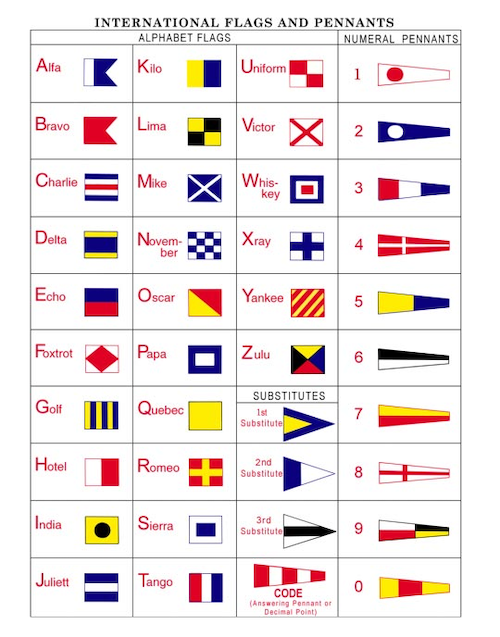
If you’re curious as to the deeper meaning behind these signals, here’s some nautical flags know-how.
1. Shapes and types are important.
Nautical flags mostly take the forms of squares, though you’ll also see pendants, which are triangular with a flat tip. You’ll additionally see what’s called substitutes (alternately called repeaters), which are triangles. Since this is a “flags 101” article, we’ll focus on the squares and pendants. They’re the ones you’re more likely to see in common boating situations.
2. Learn the letters and numbers.
There are 26 square nautical flags, each representing a different letter of the alphabet. More accurately, each represents the international code word connected to the letters of the alphabet, such as Alpha, Bravo, Charlie, Delta, and so on. In addition, there are 10 pendants for the numbers zero through nine. For the numbers 10 and larger, a boat would combine flags.
3. Colors are by choice.
The only colors you’ll find on nautical flags are black, blue, red, yellow, and white. These colors stand out quite well when seen with your own eyes on the horizon or through binoculars. Flags can be a solid color or a combination of colors, too.
4. Solo or combined, nautical flags convey meaning.
Depending on the intended message, boats fly one flag or up to seven flags in a row.
- For example, if you see the A (Alpha) flag , this means “diver down, keep clear.”
- If you see the W (Whiskey) flag , the boat has a medical emergency and needs help.
- The combination of the D (Delta) and V (Victor) flags , meanwhile, means “I’m maneuvering with difficulty and require assistance.”
- The J (Juliet) and L (Lima) flags mean “you’re running the risk of going aground.”
In fact, signals with two nautical flags typically mean some type of distress or maneuvering issue. Three or more flags can include pendants and denote things like points of the compass, geographical signals, names of ships, time and position, as well as latitude and longitude.
5. Flags are sometimes exclusive or secret language.
While boaters around the world use nautical flags to communicate common scenarios, particular situations call for their own language. Race committees combine flags to convey a race is four minutes from start, for example, or that a course has been shortened. The U.S. Navy groups together signals in ways known only to its personnel to communicate with its fellow ships.
Nautical Flags and Their Meanings
International Code Flags (also see Multiple Flags Signal Codes )
|
| ||
|
| ||
|
|
| |
|
| ||
|
| ||
|
| ||
|
| ||
|
| ||
|
|
| |
|
| ||
|
| ||
|
|
| |
|
|
| |
|
|
| |
|
| ||
|
|
| |
|
|
| |
|
|
| |
|
|
| |
|
|
| |
|
| ||
|
| ||
|
| ||
|
|
| |
|
|
| |
|
|
| |
|
|
| |
|
|
| |
|
|
| |
|
|
| |
|
|
| |
|
|
| |
|
|
| |
|
|
| |
|
|
| |
|
|
| |
|
|
| |
|
|
| |
|
|
| |
|
|
| |
|
|
| |
|
|
| |
|
|
| |
|
|
| |
|
|
| |
|
|
| |
|
|
| |
|
|
| |
|
|
| |
|
|
| |
|
|
| |
Race Committee Flags
| - AP over a numeral pennant 1-6. Postponement of 1-6 hours from the scheduled starting time. See above for images of these numeral pennants. | |||
|
|
| ||
| | |||
Yacht Club Officer Flags
| Fleet Captain | Secretary |
Miscellaneous Flags
USCG Auxiliary Patrol Boat Ensign
| Union Jack (worn most often by government vessels)
| ||
|
| |||
|
|
|
|
|
home | about | contact | advertising | privacy | link to us
Copyright © MarineWaypoints.com. All rights reserved.

- Marine Engineering
Nautical Flags Meanings | International Maritime Signal Flags
Olivia benjamin.
- August 1, 2023
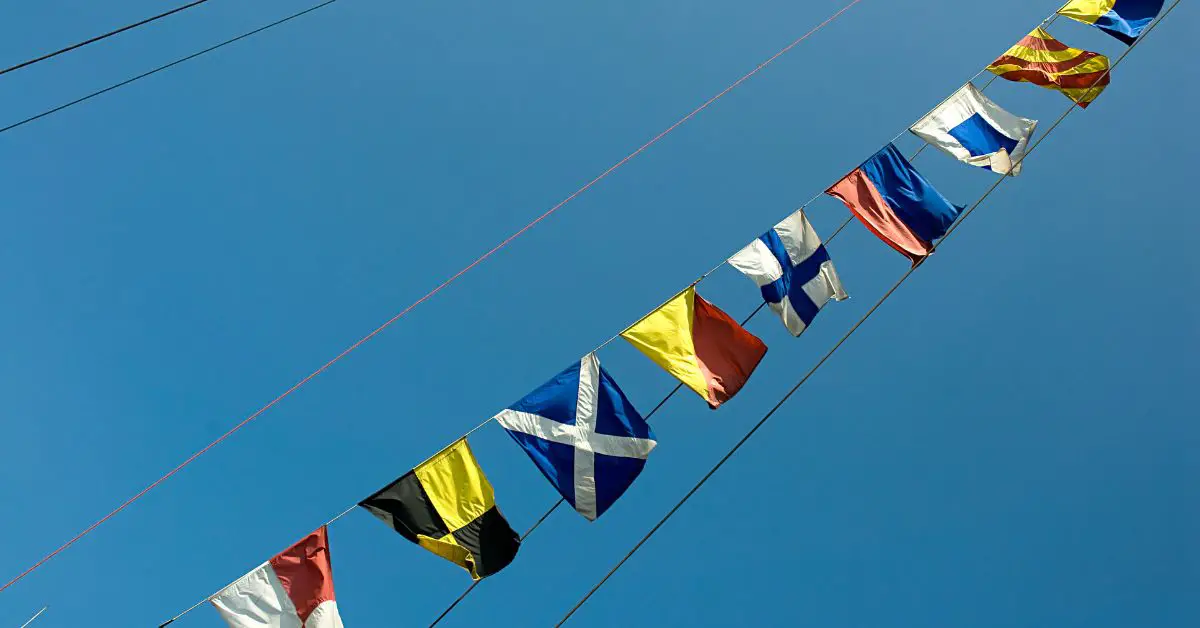
Originating from the 19th century, nautical flags are a vital communication tool amongst mariners worldwide. Boasting a rich blend of colors and patterns, these maritime signal flags still resonate today, transmitting critical information between vessels, marking hazardous cargo, and keeping the essence of our maritime heritage alive.
Each flag in this system, often square but occasionally pennant-shaped, signifies a distinct letter, number, or message, forming a robust communication network on the open seas. The configuration consists of 26 alphabetic flags, ten numeral pennants, three substitutes, and one answering pennant, all designed to be visible, even from a distance, thanks to their high-contrast color schemes.
Whether you are a seasoned sailor or a maritime enthusiast, understanding the meanings of these flags can lend an extra layer of appreciation and depth to your navigational experiences. Immerse yourself in the world of nautical flags and explore their rich history and practical uses.
Types and Meaning of Nautical Flags
Nautical flags serve as communication tools in maritime settings, each type having a unique purpose. From numeral pennants and alphabet flags to substitute flags and geographical signals, the range of international code signal flags facilitates efficient communication between vessels.
These flags foster smooth sailing and prompt communication among mariners, whether indicating dangerous cargo, signaling for assistance, or requesting a course change. Let’s explore nautical flags and learn more about the meanings behind their vibrant symbols.
1. Alphabet or Letter Flags: Symbols and their Significance
Known as the nautical flag alphabet or international maritime signal flags , alphabet flags are a set of 26 square flags that serve as a visual communication method when direct verbal exchange is impractical.
Each flag corresponds to a letter of the alphabet, thus, enabling vessels to communicate messages or spell words visually. The flags are designed with striking colors and contrasting patterns to enhance visibility. Combined or singly, these flags can convey various messages and information between vessels.
They play a pivotal role in maritime communication as part of the International Code of Signals, guaranteeing effective and standardized communication between sea-faring vessels. Here is what each alphabet flag represents:
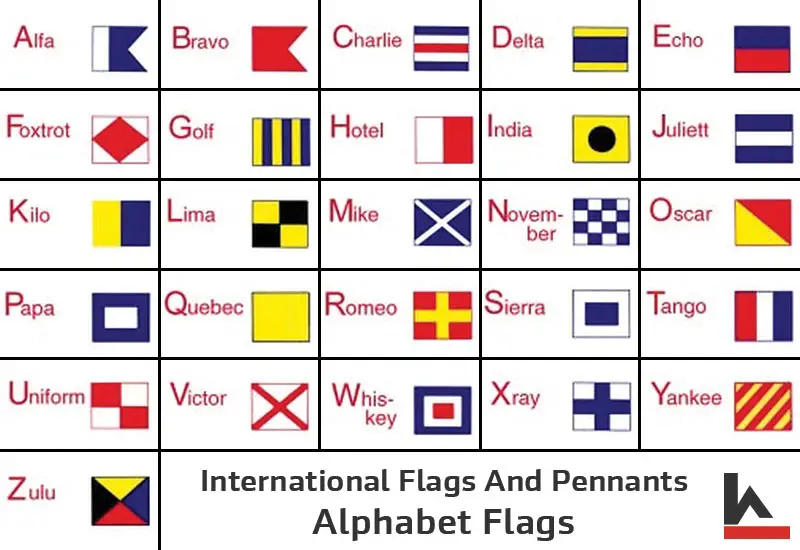
- A – Alpha : Diver down; keep clear
- B – Bravo : Dangerous cargo on board
- C – Charlie : Yes (affirmative)
- D – Delta : Keep clear; I am maneuvering with difficulty
- E – Echo : Altering my course to starboard
- F – Foxtrot : I am disabled; communicate with me
- G – Golf : I require a pilot
- H – Hotel : Pilot on board
- I – India : I am altering my course to port
- J – Juliet : I am on fire; keep clear of me
- K – Kilo : I wish to communicate with you
- L – Lima : You should stop your vessel immediately
- M – Mike : My vessel is stopped, making no way through the water
- N – November : No (negative)
- O – Oscar : Man overboard
- P – Papa : All personnel return to ship; It is dangerous to overtake me
- Q – Quebec : My vessel is healthy, and I request free pratique
- R – Romeo : The way is off my ship; you may feel your way past me
- S – Sierra : I am operating astern propulsion
- T – Tango : Do not pass ahead of me
- U – Uniform : You are running into danger
- V – Victor : I require assistance
- W – Whiskey : I require medical assistance
- X – X-ray : Stop carrying out your intentions and watch for my signals
- Y – Yankee : I am dragging anchor
- Z – Zulu : I require a tug
2. Numeral Pennants: Numbers at Sea
Numeral pennants are vital in conveying numerical information between vessels. These flags convey numerical information between ships, allowing for effective communication without needing verbal or written messages.
There are ten numeral pennants, each representing a specific number from zero through nine. To communicate a number greater than nine, multiple flags can be combined to represent the intended number. Here is a guide to these numeral flags and their numerical equivalents:
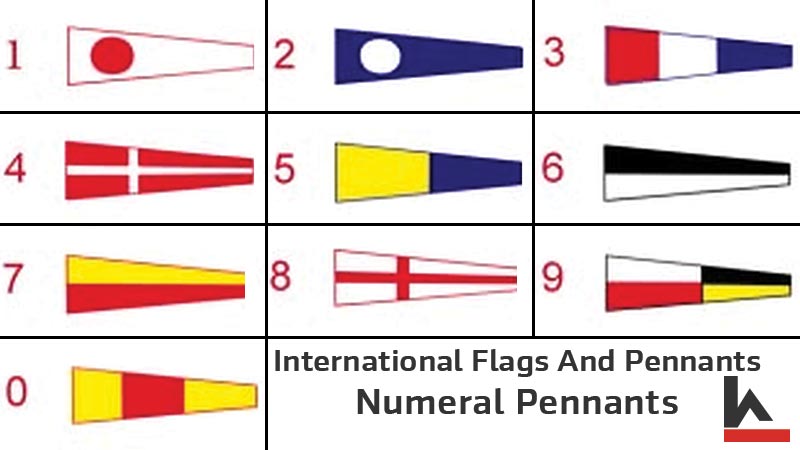
- Numeral pennant zero: Represents the number zero
- Numeral pennant one: Represents the number one
- Numeral pennant two: Represents the number two
- Numeral pennant three: Represents the number three
- Numeral pennant four: Represents the number four
- Numeral pennant five: Represents the number five
- Numeral pennant six: Represents the number six
- Numeral pennant seven: Represents the number seven
- Numeral pennant eight: Represents the number eight
- Numeral pennant nine: Represents the number nine
Using these numeral flags greatly enhances the quick and efficient transmission of numerical data between ships, ensuring smooth navigation.
3. Substitute Flags: Streamlining Communication
Also referred to as repeater flags, substitute flags are used to navigate situations where a letter appears multiple times in a communication message. These three flags, part of the International Code of Signals, streamline the entire process of communication.
When a letter repeats in a signal, the corresponding substitute flag is used in its place. For example, if a signal includes “B” multiple times, the substitute flag for “B” is used for its subsequent appearances. Here’s what each substitute flag is intended for:
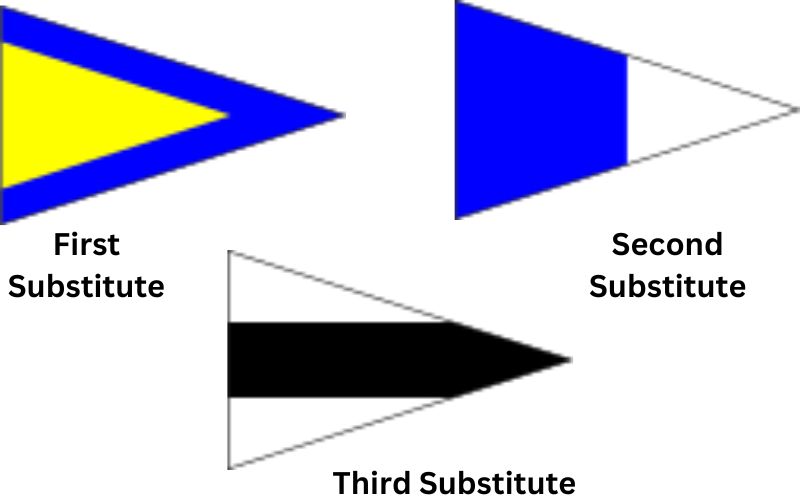
- 1st Substitute : Used as substitutes for of “A”
- 2nd Substitute : Used as substitutes for “B”
- 3rd Substitute : Used as substitutes for any letter other than of “A” or “B”.
Substitute flags are also used to signal certain phrases like “I am altering my course to port” by flying the substitute flag for the letter “I” followed by the flag representing the letter “P”.
It is important to note that substitute flags do not have any specific meaning and are only used to replace letters that have already been signaled. They are an important component of the nautical flag and are used to streamline and simplify the process of maritime communication.
Related Article: Boat Flags, Nautical Flags and Marine Flags: Types and Meanings
4. Decoding Flags: Solo or Combined
Nautical flags, flown solo or in combination, convey diverse meanings. Each flag encapsulates a specific message, fostering effective communication at sea.
A single flag might indicate a vital message. For instance, the Alpha “A” flag signals a diver’s presence underwater, warning nearby vessels to steer clear. In contrast, the Whiskey “W” flag alerts others of a medical emergency onboard.
Signals of two flags often hint at distress or maneuvering issues. For example, a combination of the Hotel (H) and Sierra (S) flags shows that a vessel cannot maneuver due to an external factor, prompting nearby vessels to keep their distance and lend assistance if possible.
When communication demands compass points, geographical signals, or positional details, mariners use a combination of three or more flags. These advanced signals transmit precise information to foster operational efficiency.
The Role and Importance of Nautical Flags
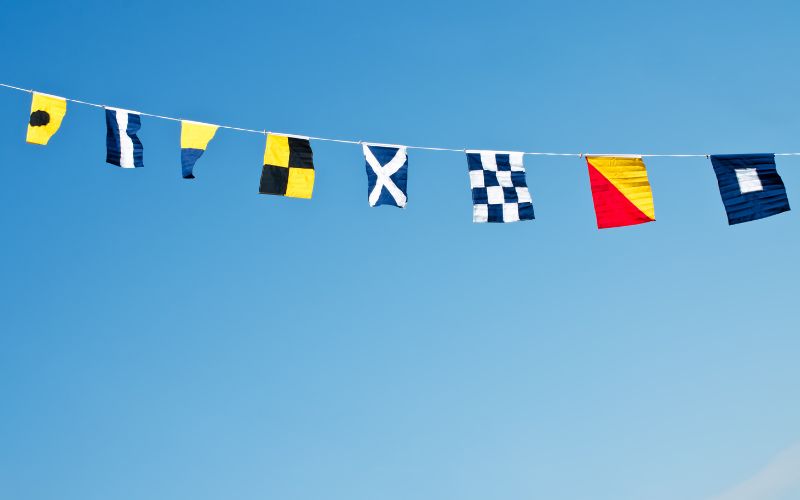
Nautical flags serve as a crucial tool for universal communication among mariners, transcending linguistic barriers to convey messages and information efficiently. Here are some roles of nautical flags:
1. Communication Between Ships and Boats
These flags allow sailors to rapidly communicate with other nearby seafaring vessels, thus providing timely alerts about potential hazards or special circumstances.
For instance, an Alpha flag, marked with a red and white diagonal stripe, will be hoisted if a diver is in the water. This alerts other vessels to steer clear of the area. In emergencies, flags like the Oscar Flag, which is orange and yellow, or the Papa flag, designed in blue and white, signal the need for immediate help.
2. Communication Between Ships
Using nautical flags for communication between ships is highly efficient and reliable. However, there can be unavailability or poor visibility of a specific flag. In such instances, substitute flags are utilized to ensure the continuation of effective communication.
Repeater flags are another essential signaling instrument between vessels. These confirm that a message from the transmitting ship has been correctly received and understood, enhancing signal accuracy.
Together, the systematic use of these nautical flags ensures the elimination of miscommunication, enabling the exchange of crucial information from navigational updates to warnings about lurking hazards – all without any language barrier.
3. Marking Missing Vessels
Nautical flags also significantly ensure maritime safety by helping mark and locate missing boats and ships. Certain flags are explicitly developed for this purpose.
For instance, the “Maneuvering Flag – Port” is raised to signal that a vessel is changing direction. This information is vital for search and rescue operations, providing valuable insights about the vessel’s last known position and intended movement.
Another commonly used flag during such situations is the “Nautical Signal Flag – Number 8.” Frequently associated with a missing vessel, this flag signals all other boats and ships to be on high alert and actively look out for any signs of the missing vessel’s whereabouts.
4. Geographical Signals
Nautical flags are used to represent specific geographical signals and their meanings. For example, the “Nautical Signal Flag – Alpha” indicates a ship’s position at the beginning of a series of flags representing geographical names. By hoisting this flag, sailors can communicate details about their location or the location of a specific point of interest.
Another important flag is the “Nautical Signal Flag – Bravo,” which signifies a ship’s position in the middle of a series of flags representing geographical names. This flag helps mariners identify their bearings more accurately.
Geographical signals provided by nautical flags play a vital role in navigation activities, enabling effective vessel coordination and promoting safety in maritime operations.
5. Sailing’s Secret Language
While nautical flags provide a universal code for maritime communication, specific scenarios call for a unique combination of flags that serve as a secret language among mariners.
A typical example is during boat races, where race committees use a unique combination of flags to convey specific messages to the participants, such as signaling the start of a race or indicating course alterations.
Similarly, naval forces like the U.S. Navy use specific signal combinations exclusive to their operations to communicate between their ships.
Nautical flags, incorporating alphabet flags, numerical pennants, and substitute flags, characterize a standardized system for efficient maritime communication. These flags serve as a high-functioning visual language, enabling crucial data exchange, promoting safe navigation, and seamless coordination among sea vessels.
Resting on international maritime codes, this mode of communication ensures uniformity and clarity across global marine borders. From distress signals, identification codes, and basic navigational instructions, nautical flags play a key role in maintaining safety and connectivity within our oceans and waterways.
Therefore, these vibrant flags on ships and boats aren’t just decorative and embody a centuries-old communication system vital for smooth maritime operations.
Related Article: Marine Communication Systems and Navigational Equipment in Ships
What is the Steering Wheel on a Ship Called?
The ship steering wheel holds a special place in maritime history, from tales of daring adventures on the high seas
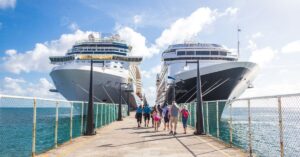
Boat vs Ship: The Difference Between a Boat and a Ship
Have you ever wondered what sets a boat apart from a ship? While these terms are often used interchangeably, the
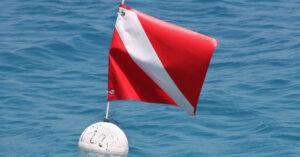
Dive Flags: What is a Dive Flag & Types of Diver Down Flags
Scuba divers and water enthusiasts grasp the necessity of safety while diving into the underwater realm. A crucial instrument that
Workshop Insider Newsletter
Be a workshop insider get our latest collection of news and announcements delivered to your inbox..., latest articles, a guide to naming your boat: finding the perfect name for your boat.
- June 25, 2024
- Boats , Marine Engineering
Best Way to Avoid Overloading Your Boat and Keep Your Boat Capacity Under the Weight Limit
- June 24, 2024
Navigating the Darkness: Understanding Boat Navigation Lights and the Different Types
Boat collisions: how to avoid collisions with another boat.
- September 12, 2023
The Ultimate Guide to Pipeliner Welding Hoods: Features, Benefits, Buying Guide, and Best Practices
- Welding Helmets Buying Guides
- September 11, 2023

- Privacy Policy
- Terms of Use
- Affiliate Disclosure
Get Your Copy of Our
FREE E-Book
Guide to MIG Welding
WELDING POCKET REFERENCE


Set Sail to Victory: Mastering Sailboat Racing Flags and Signals
Sailboat racing is a thrilling and challenging sport that requires skill, strategy, and knowledge of sailing rules and regulations. One of the essential components of sailboat racing is the use of flags and signals to communicate important information to the sailors.
Sailboat racing flags and signals are a standardized system used to convey messages about the course, starting times, penalties, and other critical information. In this article, we will explore the various sailboat racing flags and signals and their importance in the sport.
The Importance of Sailboat Racing Flags and Signals
Sailboat racing flags and signals are a set of visual cues used to communicate important information to sailors during a race. These signals can indicate the start and end of a race, changes in wind direction, or other important information that can affect a sailor’s strategy.
Understanding these signals is critical for any sailor who wants to compete in a sailboat race. Some common sailboat racing flags and signals include the “preparatory” flag, which indicates the start of the race is imminent, and the “postponement” flag, which indicates a delay in the start of the race.
Sailboat racing flags and signals are essential to the smooth and safe conduct of sailboat races. Without these flags and signals, sailors would be unable to navigate the race course safely or understand the starting times, course changes, or penalties.
Flags and signals provide a standardized system of communication that ensures that all sailors have the same information at the same time. This, in turn, promotes fair competition and ensures that all sailors have an equal opportunity to win.
The Basic Sailboat Racing Flags and Signals
The World Sailing ( WS ) is the world governing body for the sport of sailing (until 14 November 2015 named as International Sailing Federation or ISAF) has established a standardized system of sailboat racing flags and signals that are used worldwide. These flags and signals communicate essential information about the race, such as the starting times , course changes , penalties , and finish line . Below are the most common sailboat racing flags and signals:
The Preparatory Signal
The preparatory signal is the first signal made before the start of a sailboat race. This signal indicates that the race is about to start and that the boats should be prepared to start racing. The preparatory signal is usually made 5 to 10 minutes before the start of the race, depending on the size and type of race.
During the preparatory signal, the race committee displays the preparatory flag, which is a solid white flag with a blue horizontal stripe. The preparatory flag is displayed until the starting signal is made. Boats that cross the starting line before the starting signal is made are considered to have started early and may be penalized.
The Starting Signal
The starting signal is the second signal made in a sailboat race. This signal indicates that the race has officially started, and the boats can begin racing. The starting signal is usually made immediately after the preparatory signal, although there may be a delay if conditions are not suitable for racing.
The starting signal is made using the starting gun or horn. Boats must cross the starting line after the starting signal is made, or they will be considered to have started late and may lose valuable time.
The General Recall Signal
The general recall signal is made when the race committee determines that the starting sequence has not been fair or equal for all boats. This signal indicates that the race will be restarted.
During the general recall signal, the race committee displays the first substitute flag, which is a blue and white flag with a blue square in the center. Boats must return to the starting line and prepare to start again.
The Individual Recall Signal
The individual recall signal is made when a specific boat is identified as starting early. This signal indicates that the identified boat must return to the starting line and start again.
During the individual recall signal, the race committee displays the X flag, which is a black flag with a white square in the center. The identified boat must return to the starting line and start again after all other boats have started.
The Postponement Signal
The postponement signal is made when conditions are not suitable for racing. This signal indicates that the start of the race will be delayed until conditions improve.
During the postponement signal, the race committee displays the AP flag, which is a solid blue flag. Boats must return to the starting area and wait for further instructions.
The Abandonment Signal
The abandonment signal is made when conditions become too dangerous for racing. This signal indicates that the race will be abandoned, and all boats must return to shore.
During the abandonment signal, the race committee displays the N flag, which is a solid black flag. Boats must stop racing and return to shore immediately.
The Shortened Course Signal
The shortened course signal is made when conditions are not suitable for completing the full race course. This signal indicates that the race course will be shortened to ensure the safety of the boats and sailors.
During the shortened course signal, the race committee displays the S flag, which is a solid white flag with a blue square in the center. Boats must complete the shortened course and cross the finish line.
The Finish Signal
The finish signal is the final signal made in a sailboat race. This signal indicates that the race is over, and the boats have completed the race course. The finish signal is usually made when the boats cross the finish line.
During the finish signal, the race committee displays the finishing flag, which is a solid white flag with a blue vertical stripe. Boats must cross the finish line and complete the race. The boats are then ranked based on the order in
Additional Sailboat Racing Flags and Signals
In addition to the basic sailboat racing flags and signals, there are other flags and signals used in sailboat racing. These flags and signals communicate additional information about the race, such as penalties and rule enforcement. Below are some additional sailboat racing flags and signals:
The Penalty System
In sailboat racing, the penalty system is an important mechanism to ensure fair play and discourage cheating. The penalty system involves the use of penalty turns, which is a requirement for a boat to make a 360-degree turn as a result of committing a rule violation. The penalty turns must be completed as soon as possible, and failure to do so will result in further penalties.
The penalty system is signaled by the display of the “yellow flag” by the race committee boat. This flag is accompanied by a horn blast, which signifies that a penalty has been given to a boat. If a boat receives a penalty, it must complete the penalty turns as soon as possible.
The Black Flag Rule
The black flag rule is a sailing rule that is used to discourage boats from starting too early. Under this rule, if a boat is over the starting line when the starting signal is given, it is disqualified from the race.
The black flag is signaled by displaying a black flag with a white square in the middle. This flag is displayed with the one-minute signal before the start of the race. If a boat is over the starting line when the race starts, and the black flag is displayed, the boat is disqualified.
The Blue Flag Rule
The blue flag rule is used to indicate that a boat is in danger and requires assistance. The blue flag is displayed by a boat that requires assistance, and this signal must be acknowledged by other boats in the race.
The blue flag is displayed by a boat in distress or requiring assistance, and other boats must immediately make way for the distressed boat. If a boat fails to acknowledge the blue flag signal, it may be subject to penalties.
The Red Flag Rule
The red flag rule is used to s ignal that a race has been stopped due to an emergency situation . The red flag is displayed by the race committee boat, and all boats must immediately stop racing.
If the red flag is displayed, all boats must immediately stop racing and proceed to the designated area. The race will be restarted once the emergency situation has been resolved.
Sailboat racing flags and signals are a crucial part of the sport of sailboat racing. They provide a standardized system of communication that ensures fair competition and safe racing. Understanding these flags and signals is essential for all sailors who want to compete in sailboat racing.

What happens if a boat does not follow the sailboat racing flags and signals?
If a boat does not follow the sailboat racing flags and signals, it may be penalized or disqualified from the race.
Are sailboat racing flags and signals the same worldwide?
Yes, sailboat racing flags and signals are standardized worldwide by the International Sailing Federation (ISAF).
What is the penalty for starting early in sailboat racing?
The penalty for starting early in sailboat racing is usually a 360-degree turn penalty.
How are safety rules enforced in sailboat racing?
Safety rules are enforced in sailboat racing using the red flag rule. If a boat is identified as posing a safety risk, it will be disqualified from the race.
Can sailboat racing flags and signals change during a race?
Yes, sailboat racing flags and signals can change during a race due to weather conditions or other safety concerns.
- Recent Posts
- Responsibilities of a Fourth Engineer on Cargo Ships – September 10, 2024
- The Role of Cargo Ships in Global Trade – August 22, 2024
- Report: Yang Ming’s YM Mobility Explosion at Ningbo-Zhoushan Port – August 9, 2024
About the author
I worked as an officer in the deck department on various types of vessels, including oil and chemical tankers, LPG carriers, and even reefer and TSHD in the early years. Currently employed as Marine Surveyor carrying cargo, draft, bunker, and warranty survey.
Latest posts

Is Maritime Security Necessary on Modern Ships?
It’s vital for ships to stay vigilant. Isolation from land means having no backup or protection for miles, making them vulnerable to attacks and other threats. Equip modern ships using modern maritime security methods.

Responsibilities of a Fourth Engineer on Cargo Ships
A Fourth Engineer on cargo ships oversees engine room operations, machinery maintenance, and ensures compliance with regulations like MARPOL.

The Quality Control Process in Marine Manufacturing
Companies in the marine manufacturing space must have tight and effective quality control processes. What steps should an effective quality control process include?
- Types of Sailboats
- Parts of a Sailboat
- Cruising Boats
- Small Sailboats
- Design Basics
- Sailboats under 30'
- Sailboats 30'-35
- Sailboats 35'-40'
- Sailboats 40'-45'
- Sailboats 45'-50'
- Sailboats 50'-55'
- Sailboats over 55'
- Masts & Spars
- Knots, Bends & Hitches
- The 12v Energy Equation
- Electronics & Instrumentation
- Build Your Own Boat
- Buying a Used Boat
- Choosing Accessories
- Living on a Boat
- Cruising Offshore
- Sailing in the Caribbean
- Anchoring Skills
- Sailing Authors & Their Writings
- Mary's Journal
- Nautical Terms
- Cruising Sailboats for Sale
- List your Boat for Sale Here!
- Used Sailing Equipment for Sale
- Sell Your Unwanted Gear
- Sailing eBooks: Download them here!
- Your Sailboats
- Your Sailing Stories
- Your Fishing Stories
- Advertising
- What's New?
- Chartering a Sailboat
- Sailboat Flag Etiquette
Sailboat Flag Etiquette: What You Need to Know
Sailboat flag etiquette is steeped in maritime tradition and enshrined in law. If you're new to the world of sailing, you may have wondered about the various flags that you see flying on other sailboats or that you are expected to fly on your own. What do they mean? How should they be displayed? What are the rules and traditions that govern them?
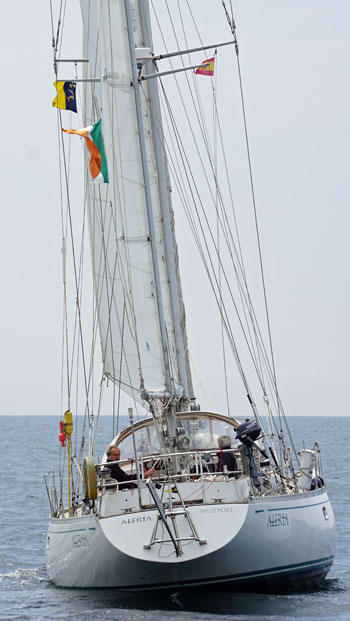
An experienced sailboat skipper will know that flag etiquette is a way of showing respect, courtesy and recognition to other vessels, countries and organizations.
It also helps you communicate important information, such as your nationality, your club affiliation, your intentions or your distress.
For the less experienced we'll explain the basics of sailboat flag etiquette and how it should be applied in practice:
- The types of flags that you can fly on your boat;
- The sizes and positions of the flags;
- The occasions and situations when you should fly certain flags;
- The common mistakes and pitfalls to avoid when flying flags.
The skipper of the Bowman 57 staysail ketch shown here is correctly flying a burgee (the Flying Fish burgee of the Ocean Cruising Club ) from the port spreader, and a courtesy ensign (of Spain in this case) from the starboard spreader.
The ensign, in this case that of the Republic of Ireland, is flown from a flag halyard from the mizzen mast to the end of the mizzon boom. Alternatively the ensign could be flown from a staff attached to the taffrail.
The Types of Flags
There are many types of flags that you can fly on your boat, but the most common ones are:
- The ensign: This is the flag that shows the country of registry of your boat and indicates its nationality. It is usually flown at the stern of the boat, as close as possible to the waterline. It is the most senior position for a flag on a boat and it should always be larger than any other flag. A UK flagged boat (sail or power) must wear the national maritime flag, the Red Ensign, unless entitled to wear a special ensign.
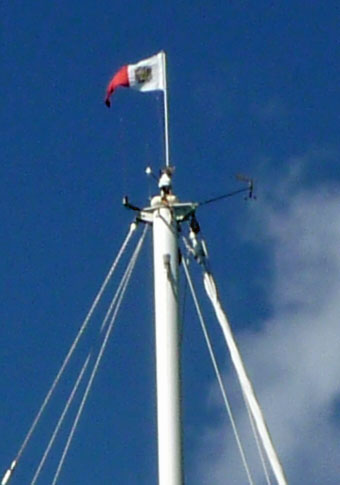
- The burgee: This is the flag that shows the yacht club or association that you belong to. It is usually flown at the main masthead of the boat above any other flag, but can be flown from the port spreader unless otherwise stipulated under a special warrant.
- The courtesy flag: This is the flag that shows the national flag of the country that you are visiting or whose waters you are sailing in. It is a sign of respect and goodwill to the host country and it should be flown at the starboard spreader. It should be hoisted as soon as you enter foreign waters and lowered as soon as you leave them.
- The Q flag: This is a yellow flag that indicates that you are requesting clearance from the local authorities when entering a foreign port. It is also flown at the starboard spreader of the boat, below the courtesy flag if there is one. It should be hoisted before you enter the port and lowered after you have been cleared.
- The signal flags: These are flags that have specific meanings in the International Code of Signals. They can be used to spell out messages or to convey information such as your position, your course, your speed, your intentions or your distress. They can be flown individually or in combinations at various locations on the boat.
- The private signal: This is a personal or family flag that has no official meaning or recognition. It can be flown at the port spreader of the boat, below any other flag. It is optional and purely decorative.

The Sizes and Positions of the Flags
The sizes and positions of the flags on your boat are important for both aesthetic and practical reasons. They should be proportionate to your boat size, visible from a distance and clear from any obstruction.
The general rules for sizing and positioning flags are:
- The ensign should be one inch on the fly (the length) for every foot of overall length of your boat. It should be flown on the stern staff or on a gaff if there is one.
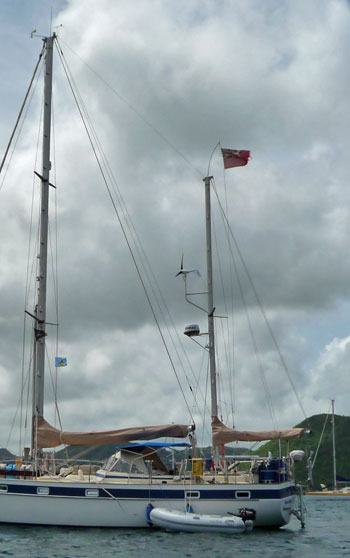
- The burgee should be half an inch on the fly for every foot of overall length of your sailboat or five-eighths of an inch for every foot of overall length of your powerboat. It should be flown at the main masthead or on a pigstick (a vertical extension) if there is one.
- The courtesy flag should be the same size as the burgee or slightly smaller. It should be flown at the starboard spreader, preferably on its own halyard.
- The Q flag should be the same size as the courtesy flag or slightly smaller. It should be flown at the starboard spreader, below the courtesy flag if there is one, on its own halyard.
- The signal flags should be sized according to their function and meaning. They can be flown individually or in combinations at various locations on the boat, such as the masthead, the yardarm, the bow or the stern of the boat.
- The private signal should be the same size as the burgee or slightly smaller. It should be flown at the port spreader, below any other flag, on its own halyard.
The Occasions and Situations When You Should Fly Certain Flags
The occasions and situations when you should fly certain flags on your boat depend on where you are, what you are doing and who you are with. Some flags are mandatory, some are optional and some are forbidden.
The general rules for flying flags are:
- You must fly your ensign at all times in daylight, especially when near to or in sight of land or another boat. You must also fly your ensign when entering or leaving a foreign port and on demand. You can fly your ensign at night if you wish, but it is not required.
- You can fly your burgee at any time, but it is customary to hoist it at 0800 and lower it at sunset. You can also fly your burgee at night if you wish, but it is not required.
- You must fly the courtesy flag of the country that you are visiting or whose waters you are sailing in as soon as you enter their jurisdiction and until you leave it. You must also fly the Q flag when entering a foreign port until you have been cleared by the local authorities. You can lower the Q flag after you have been cleared, but you should keep the courtesy flag until you leave the port or the country.
- You can fly signal flags whenever you need to communicate with other boats or shore stations using the International Code of Signals. You can also fly signal flags for decorative purposes, such as dressing your boat for a special occasion, but you should avoid using flags that have specific meanings or that could cause confusion.
- You can fly your private signal whenever you want, but it has no official significance or recognition. It is purely a personal or family emblem.
The Common Mistakes and Pitfalls to Avoid When Flying Flags
Flying flags on your boat can be fun and rewarding, but it can also be tricky and challenging. There are some common mistakes and pitfalls that you should avoid when flying flags, such as:
- Flying an incorrect, damaged, wrongly sized or otherwise invalid ensign. This is a breach of law and etiquette and could lead to fines or penalties.
- Flying a special ensign without being entitled to do so. This is a privilege granted by a warrant from the Admiralty or by an Act of Parliament and it requires certain conditions to be met.
- Flying a burgee that does not match your ensign or that is higher than your ensign. This is a sign of disrespect and ignorance and could offend other boats or authorities.
- Flying more than one burgee at a time. This is considered sloppy and excessive and could imply that you are showing off or indecisive.
- Flying a courtesy flag that is larger than your burgee or that is above your burgee on the same halyard. This is a sign of subservience and inferiority and could insult your own country or club.
- Flying a Q flag when you have already been cleared or when you are leaving a port. This is unnecessary and confusing and could cause delays or misunderstandings.
- Flying signal flags that have specific meanings or that could cause confusion for decorative purposes. This is irresponsible and dangerous and could lead to accidents or incidents.
- Flying a private signal that resembles an official flag or that has an offensive meaning. This is misleading and rude and could provoke anger or hostility.
- And you should never, ever, fly a skull-and-crossbones flag. There is nothing amusing or glamorous about pirates.
Sailboat Flag Etiquette: A Few FAQs...
Why do some British sailboats fly a White or Blue Ensign rather than the traditional Red Ensign?
Some British sailboats fly a white or blue ensign because they belong to certain yacht clubs or organisations that have special permission to use these ensigns.
The white ensign is a variation of the national flag that is normally used by the Royal Navy, but it can also be worn by yachts owned by members of the Royal Yacht Squadron , which is a privileged yacht club with a long history and close ties to the monarchy.
The blue ensign is another variation of the national flag that is normally used by government vessels, but it can also be worn by yachts that belong to one of the 32 yacht clubs or associations that have a warrant from the Admiralty or the relevant authority to use the undefaced blue ensign.
Additionally, some yachts can wear a blue ensign defaced with the badge of their club or association, if they have a warrant for that as well. There are 57 yacht clubs or associations that have this privilege.
These special or privileged ensigns are considered a mark of distinction and honour, and they should only be flown with proper authorisation and following the rules and regulations of wearing them.
What is the difference between an ensign and a burgee?
An ensign is a flag that shows the nationality of the vessel and must be worn at the stern or as close to it as possible. A burgee is a flag that shows the membership of a yacht club or sailing association and can be worn at the masthead or the port spreader.
What is a special ensign and how can I get one?
A special ensign is a variation of the national flag that can be worn by certain yachts that belong to a privileged yacht club or organisation. To get one, you need to apply for a warrant from the Admiralty or the relevant authority and follow the rules and regulations of wearing it.
How big should my flags be and how should I hoist them?
The size of your flags depends on the length of your vessel, but as a general rule, your ensign should be about one inch for each foot of overall length. Your burgee and courtesy flag should be smaller than your ensign, but not too small to be seen. You should hoist your flags using halyards or staffs and make sure they are not tangled, faded, or torn.
When should I raise and lower my flags?
You should raise your flags at 0800 hours or when you leave harbour, whichever is later, and lower them at sunset or when you enter harbour, whichever is earlier. You should also lower your flags when out of sight of other vessels or when nobody is aboard.
Can I fly more than one burgee or other flags on my vessel?
Traditionally, you should only fly one burgee at a time, but some yachts may choose to fly more than one to show their affiliation with different clubs or associations. However, you should always make sure that your burgee matches your ensign if you are wearing a special one. You can also fly other flags, such as signal flags, house flags, or personal flags, but they should not take precedence over your ensign, burgee, or courtesy flag.
How should I salute other vessels or authorities with my flags?
You can salute other vessels or authorities by dipping your ensign, which means lowering it halfway down the staff or halyard and then hoisting it back up. You should only do this if you receive a salute first or if you are passing by a naval vessel, a Coast Guard vessel, or a foreign warship.
What are the rules for flying flags in a race?
The rules for flying flags in a race may vary depending on the organising authority, but generally, you should not fly your ensign during a race, as this signals that you are not racing. You should also follow any instructions given by the race committee regarding signal flags, class flags, or protest flags.
What are the consequences of not following flag etiquette?
Not following flag etiquette may result in fines, penalties, or even confiscation of your vessel if you break the law or offend the host country. It may also cause confusion, misunderstanding, or disrespect among other sailors or authorities. Therefore, it is advisable to learn and follow the proper flag etiquette whenever you go sailing.
I wrote this article using GPT-4, OpenAI’s large-scale language-generation model, as a research assistant to develop source material. I wrote the final draft in its entirety and believe it to be accurate to the best of my knowledge.
Dick McClary
Recent Articles
The CSY 44 Mid-Cockpit Sailboat
Sep 15, 24 08:18 AM
Hallberg-Rassy 41 Specs & Key Performance Indicators
Sep 14, 24 03:41 AM
Amel Kirk 36 Sailboat Specs & Key Performance Indicators
Sep 07, 24 03:38 PM
Here's where to:
- Find Used Sailboats for Sale...
- Find Used Sailing Gear for Sale...
- List your Sailboat for Sale...
- List your Used Sailing Gear...
Our eBooks...

A few of our Most Popular Pages...

Copyright © 2024 Dick McClary Sailboat-Cruising.com
- All New England
- Martha’s Vineyard
- Rhode Island
- Travel Guides
- Dining + Nightlife
- Interior Design
- Real Estate

Discover Ocean House’s Luxurious Land and Sea Yacht Experience
Discover coastal elegance in portsmouth, rhode island, lobster boil sundays at weekapaug inn: a new england tradition, experience mediterranean magic at ocean house, millie’s nantucket: a coastal culinary gem in madaket, classic baked stuffed clams, filet au poivre with peppercorn and brandy sauce, ricotta with hot honey, buffalo wonton recipe, chicken marsala with pancetta recipe, hydrangea elegance for your table, shaken, stirred, and stocked: the fun essentials of a home bar, edgartown style, hydrangea blue style, siasconset style, tranquility unveiled: delamar southport’s new spa for ultimate relaxation, get resort ready with kate leigh’s vibrant cabana capsule collection, broadlawn farm’s sweet initiative: combating human trafficking with chunk honey, coastal luxury in narragansett, the dips at 30 devon street is a nantucket masterpiece, 9 things to know before buying a house on nantucket, be our guest | saltaire nantucket.
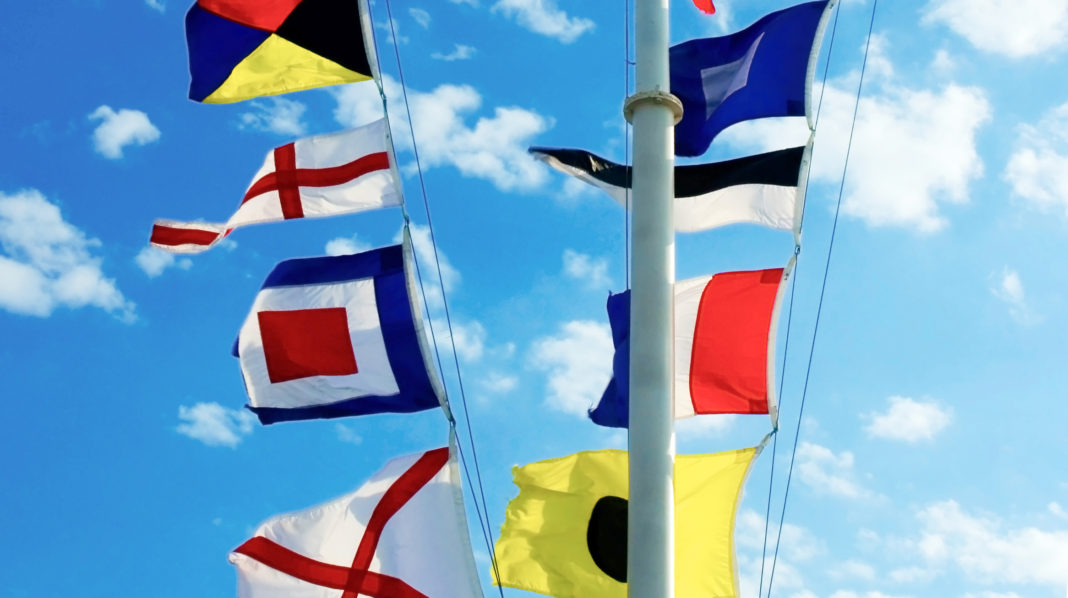
A Guide to Nautical Flags & Code Signals
Ahoy there! Have you ever wondered about those colorful flags you see fluttering on docks and seaside buildings? They’re called nautical flags, or burgees, and they have an interesting history. In the past, they were essential for communication between ships at sea, before radios and sonar came along. But nautical flags are more than just pretty decorations – they serve a practical purpose for boaters too.
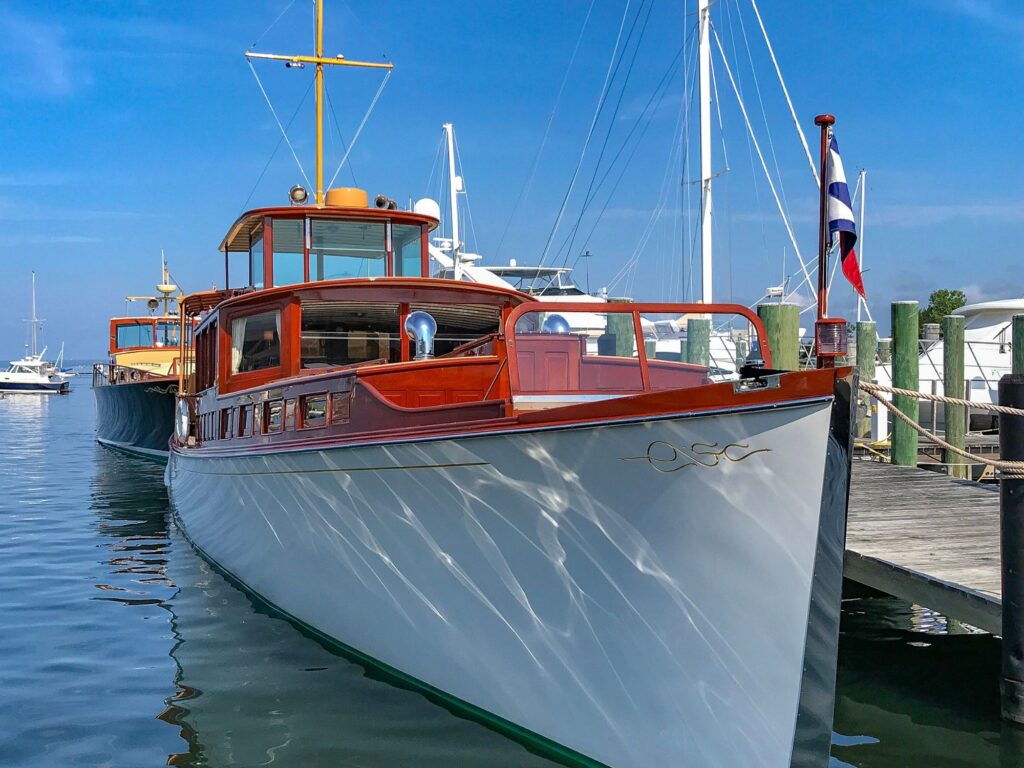
Nautical flags are part of an international code signaling system. These flags represent letters of the alphabet, numbers, and other signals, and they come in vibrant colors like red, blue, yellow, black, and white for maximum visibility. The combinations of these colors were carefully chosen to be easily distinguishable from afar. So, if you see flags that are red and white, yellow and blue, blue and white, or black and white, now you know why!
But nautical flags aren’t just for communication at sea. They also play a role in recreational boating. For example, there are flags that indicate the nationality of a vessel, the yacht club it belongs to, or even the personal interests of the boat owner. It’s like wearing a badge of honor on the water!
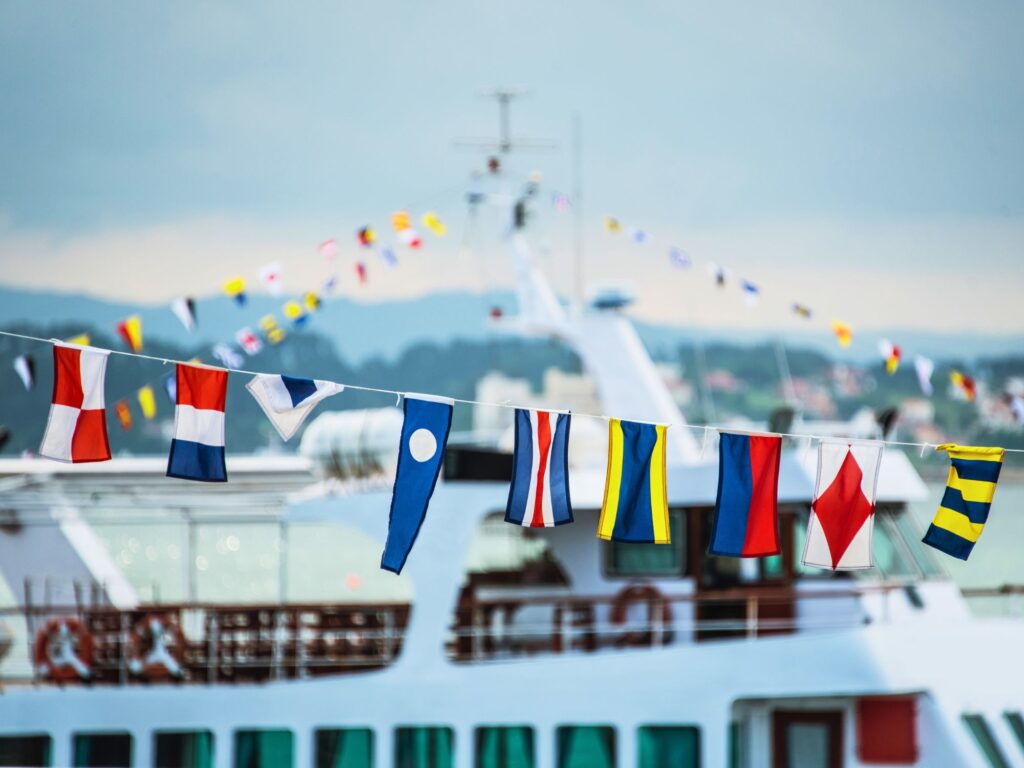
Speaking of flags, there are also important warning flags that boaters should be aware of. These flags, like the Hurricane Warning Flag and the Skin Diver Down Flag, send important messages to other vessels. They let everyone know about potentially dangerous weather conditions or the presence of divers in the area.
While technology has made nautical flags less necessary for everyday communication, it’s still a good idea for boaters to understand the basics. Who knows, maybe you can even use your newfound code skills to spruce up your beach house with some flag decorations! So, next time you spot those colorful fluttering flags, remember the fascinating history and practicality behind them. Happy boating!
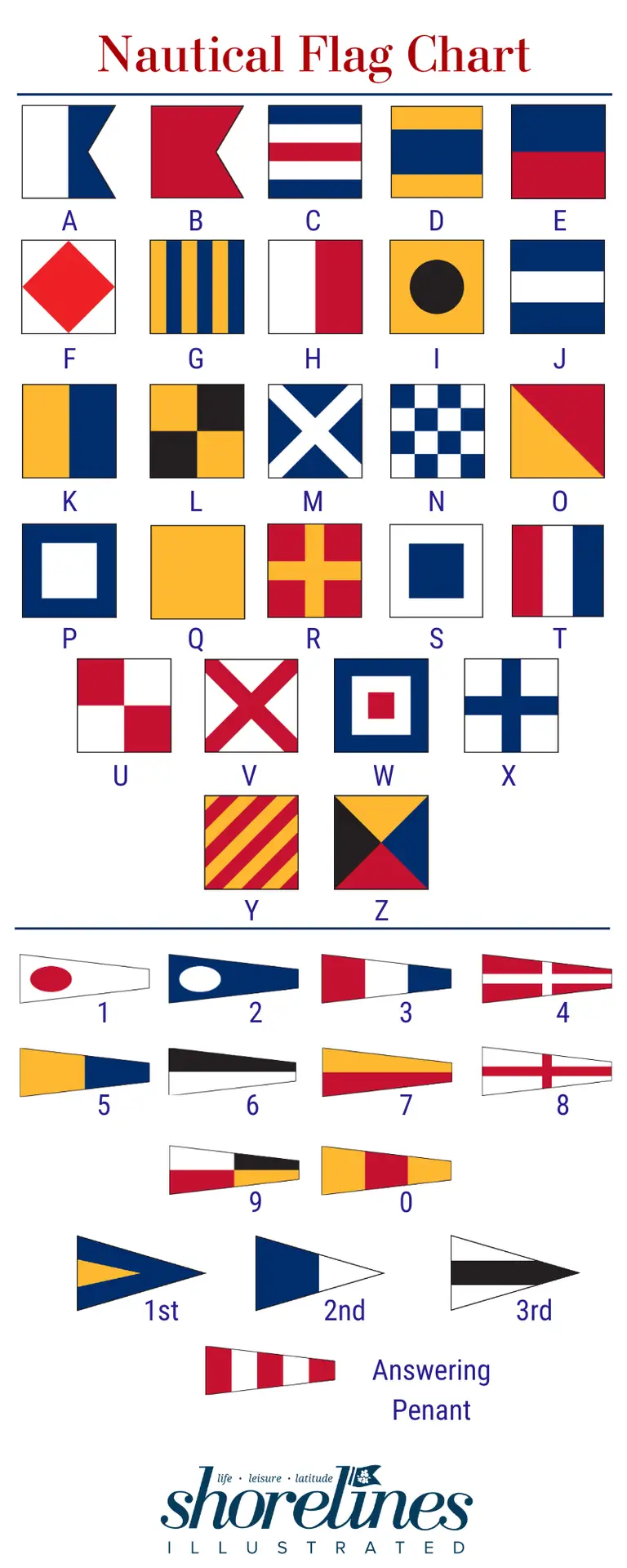
RELATED ARTICLES MORE FROM AUTHOR
Follow us on instagram @shorelinesillustrated.

Nautical flags and meanings
- No Comments

Welcome to the intriguing world of nautical flags! Seafarers have used nautical flags for generations to communicate. Each flag symbolizes a letter or message with its own design and color scheme. These flags carry vital information including distress signals, identity, and directions in marine communication. Nautical flags are fun to learn about whether you’re a sailor or a landlubber. To help you decipher the sea’s hidden language, we’ll introduce you to some of the most essential and often-used nautical flags.

A: Alpha – Diver down (Small diving vessel); keep clear
Check this video quiz ↗

B: Bravo – Carrying dangerous cargo

C: Charlie – Yes (affirmative)
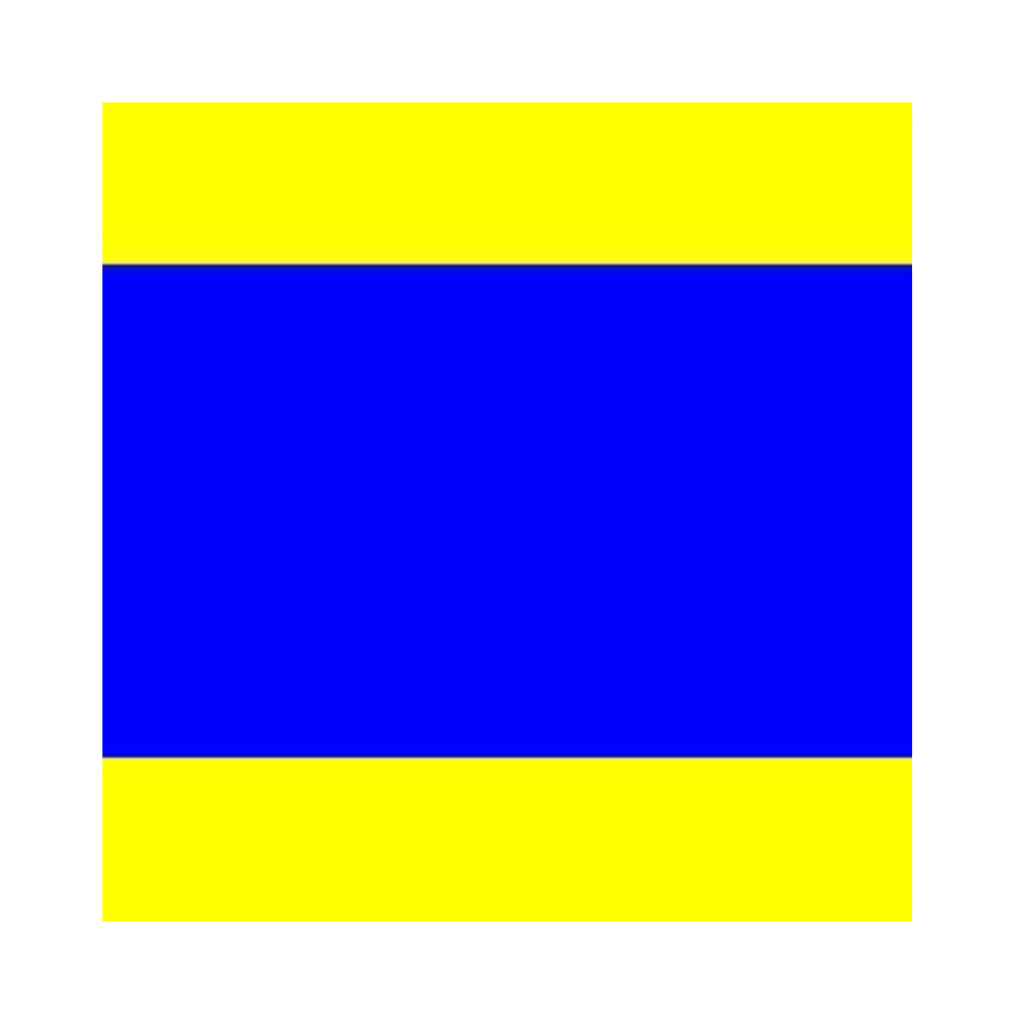
D: Delta – Keep clear of me, I am maneuvering with difficulty

E: Echo – Altering course to starboard

F: Foxtrot – I am disabled, communicate with me

G: Golf – I want a pilot
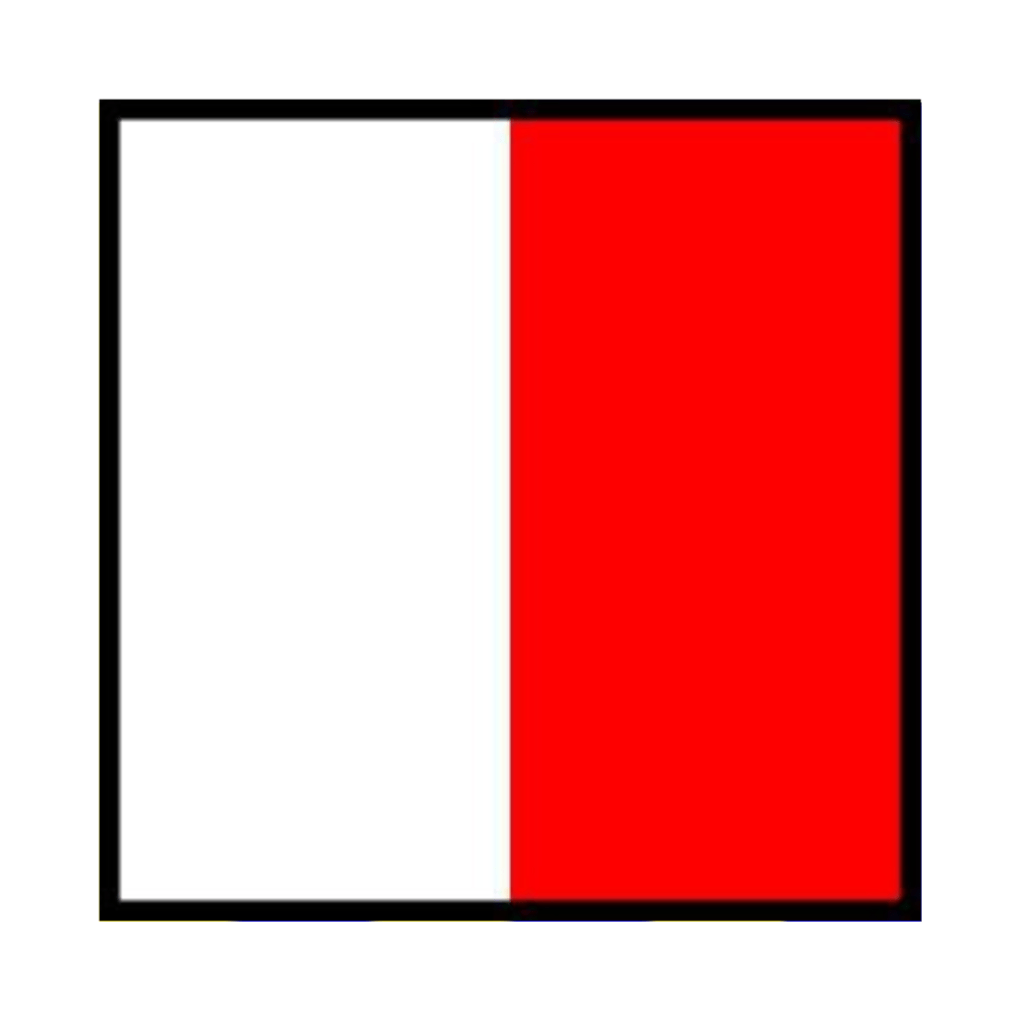
H: Hotel – A pilot on board

I: India – I am altering my course to port

J: Juliet – A vessel on fire, keep clear
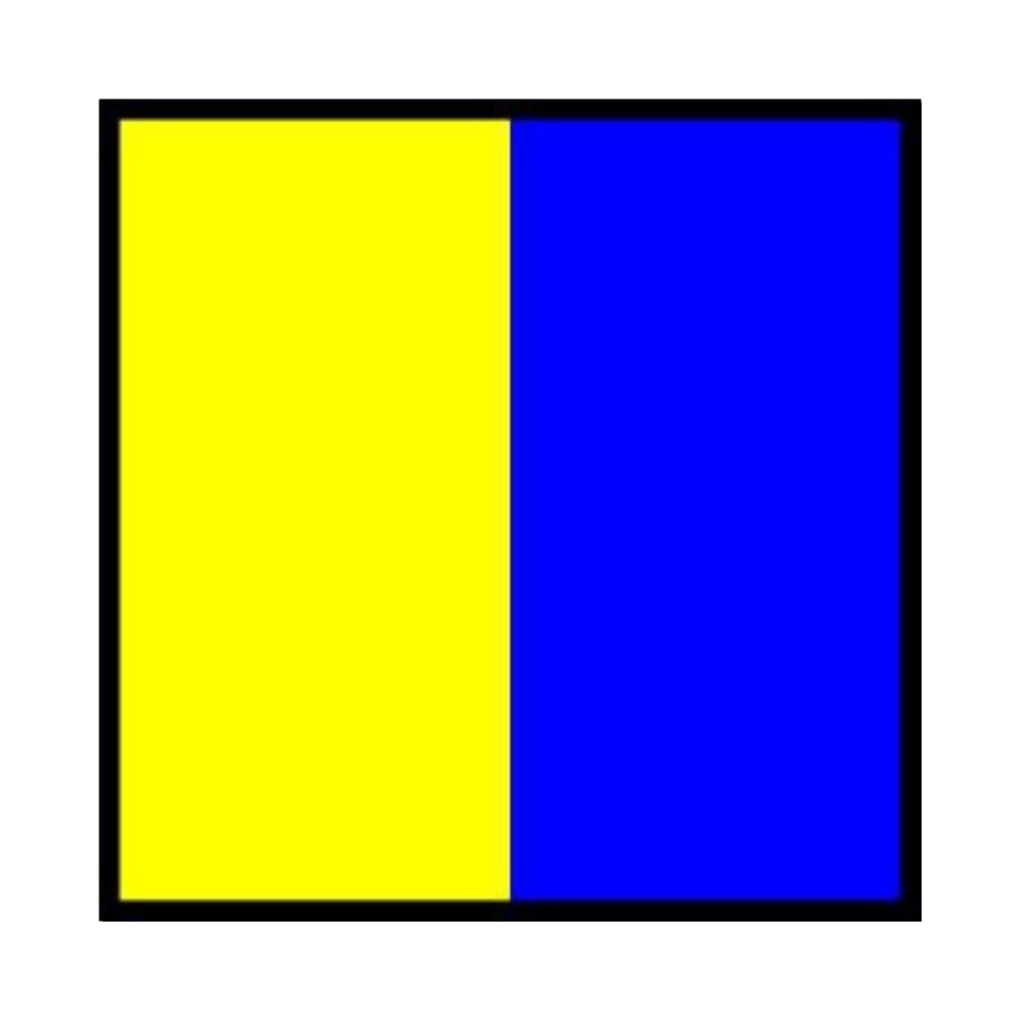
K: Kilo – I want to communicate with you
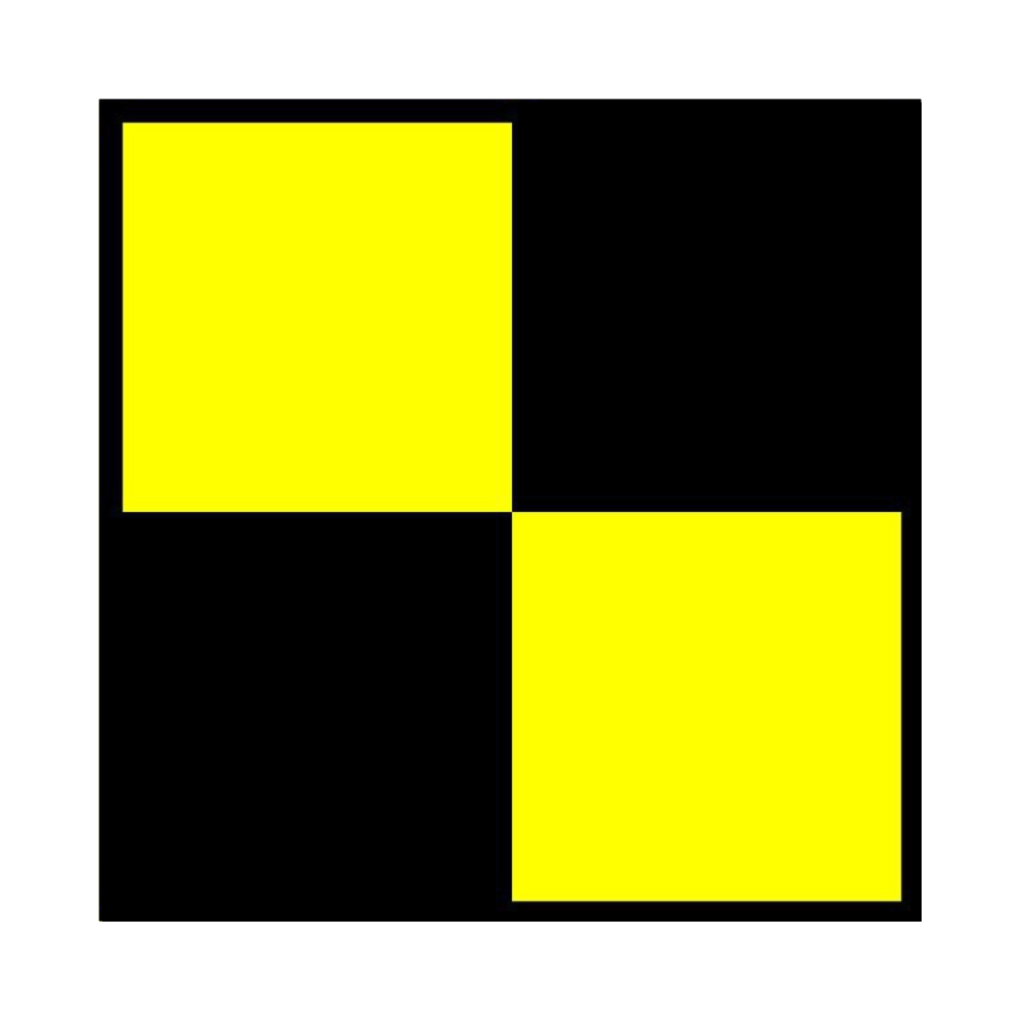
L: Lima – Sop your vessel instantly, I have something important to communicate; Come Within Hail or Follow Me (Sailing Regatta)

M: Mike – My vessel is stopped

N: November – No (negative)

O: Oscar – Man overboard

P: Papa – In port: All personnel return to the ship; the vessel is about to sail; At sea: It may be used by fishing vessels to mean: “My nets have come fast upon an obstruction”

Q: Quebec – I request free pratique

R: Romeo – Reverse Course

S: Sierra – Engines are going astern
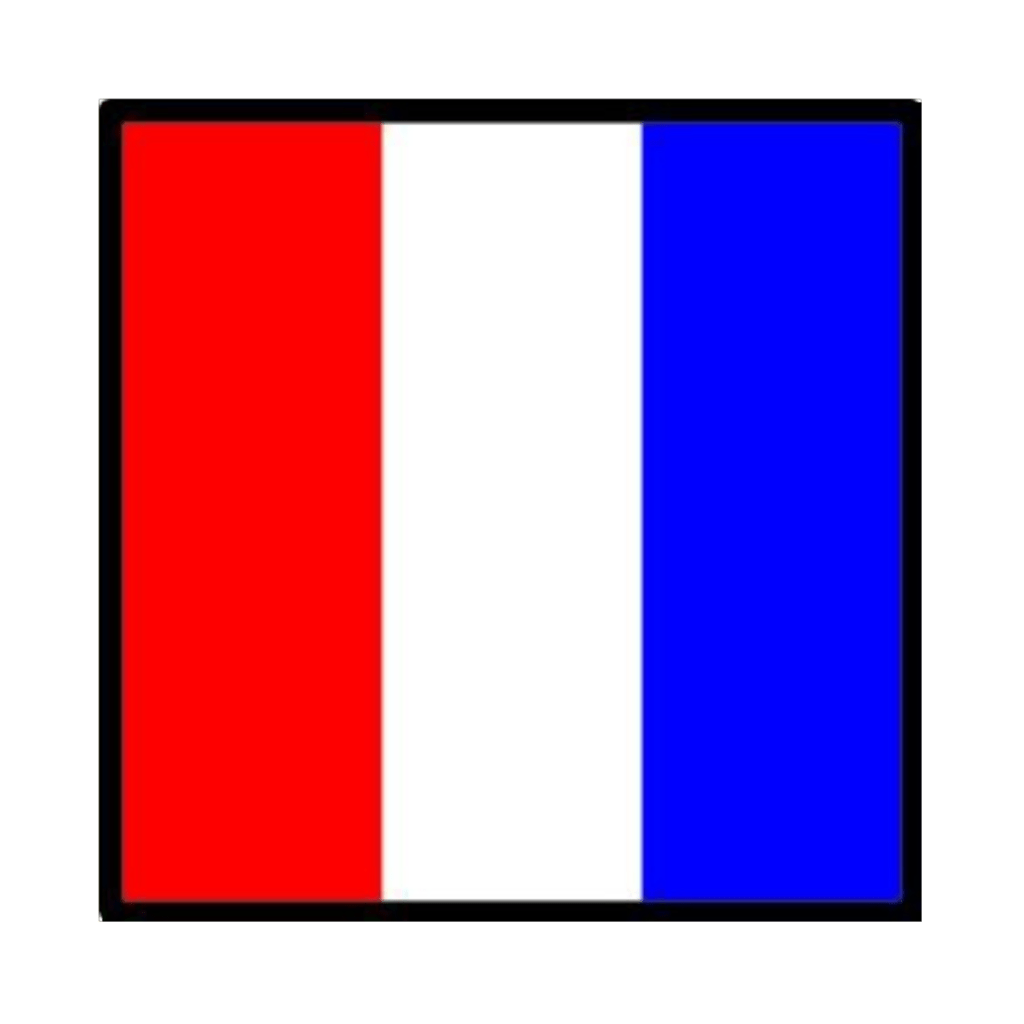
T: Tango – Keep clear; engaged in trawling (International); Do not pass ahead of me (Navy)

U: Uniform – You are heading into danger
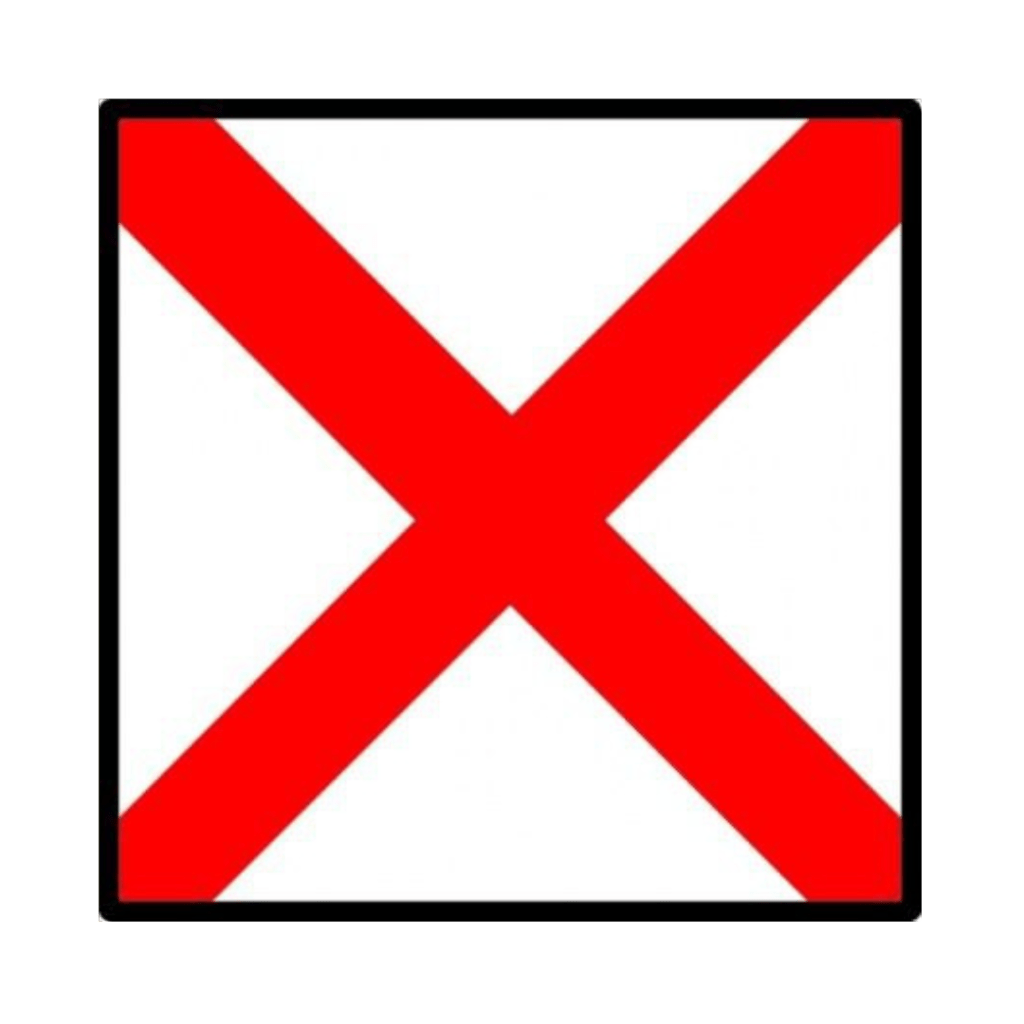
V: Victor – Require assistance

W: Whiskey – Require medical assistance

X: X-ray – Stop your intention

Y: Yankee – Am dragging anchor

Z: Zulu – I require a tug

▶ Follow Sailing Click on Youtube!
Yacht flags play an essential role in sailing, navigation, and communication among sailors. These flags are a part of the nautical flags category and are also known as nautical signal flags or sailing flags. Each flag has a specific meaning, and it is important for sailors to know them to communicate effectively and safely.
Nautical flags have been used for centuries to communicate messages between ships, and today they are still an important part of maritime tradition. Yacht flags are used for a variety of purposes, from signaling the vessel’s nationality to indicating its sailing status.
The International Code of Signals governs the use of nautical flags and sets out specific rules for their use. The code includes 26 alphabetical flags, 10 numerical pennants, and 3 substitute flags that are used to represent letters that are not included in the alphabet.
Yacht flags , in particular, are used to signal the boat’s identity, status, or intention. For example, a yellow and blue flag with a white anchor in the center is a signal for a vessel that is at anchor. A white flag with a blue square and a white cross in the center signals that the boat is a medical vessel or has a medical emergency on board.
Other popular yacht flags include the burgee, which is a triangular flag that represents the boat’s club or organization, and the courtesy flag, which is flown to show respect for the host country’s flag when sailing in foreign waters. The courtesy flag is often flown on the starboard spreader of the boat.
Navigation flags are another type of yacht flag used for signaling a boat’s movements or intentions. These flags are often used in racing or in other situations where it is important to communicate quickly and clearly. For example, a blue flag with a white diagonal stripe indicates that the boat is tacking, while a yellow and black flag signals that the boat is approaching a mark.
In addition to their practical uses, yacht flags are also an important part of maritime tradition and are often used for decorative purposes. Many sailors display their yacht flags on board their boats as a way of showing off their sailing accomplishments or their affiliation with a particular club or organization.
In conclusion, yacht flags are an important part of sailing and navigation, serving practical and decorative purposes. Knowing the meaning of each flag is crucial for effective communication and safety while on the water. So, next time you see a yacht flag waving in the wind, take a moment to appreciate the rich history and tradition behind it.
Leave a Review Cancel reply
You must be logged in to post a comment.
You may also like
Sailing spots.

Charter sailing boat in Croatia – TOP 10 tips

Australian Marine Life: A Yachter’s Guide to Beauty and Safety
Yachting basics.

Nautical Night Lights

Yacht Anodes: Everything You Need to Know
Sailing routes.

Seychelles yacht charter itinerary

Sailing Route in Croatia, from Pula along the East Coast of Istria and the Islands of Cres, Krk, Losinj.
Yacht events.
No listings were found matching your selection. Something missing? Why not add a listing? .
Sailing News

Setting Sail on a Voyage of Glory: The Fourth Turkish Presidential International Yacht Race Begins in Muğla

Celebrating the New Year on a Chartered Sailing Yacht
Faces in yachting.

Laura Dekker: The Youngest Circumnavigator – A Voyage of Resilience and Dreams

Joshua Slocum: The Lone Mariner’s Odyssey
Boat reviews.

| Sailing Click - search best yacht rental deals worldwide, discover new sailing destinations, find new yacht marinas. |
- TOP Charter Deals (updated)
- Advertising and Promotion
- Privacy Policy
- Cookie Policy
Please note that some links on our site are affiliate links. This means we may earn a commission at no extra cost to you if you click on them and make a purchase. We recommend products because we believe they add value, not because of the commission we receive. Your support helps keep our site running. If you have questions, please reach out to us.
Privacy Overview
| Cookie | Duration | Description |
|---|---|---|
| cookielawinfo-checkbox-analytics | 11 months | This cookie is set by GDPR Cookie Consent plugin. The cookie is used to store the user consent for the cookies in the category "Analytics". |
| cookielawinfo-checkbox-analytics | 11 months | This cookie is set by GDPR Cookie Consent plugin. The cookie is used to store the user consent for the cookies in the category "Analytics". |
| cookielawinfo-checkbox-functional | 11 months | The cookie is set by GDPR cookie consent to record the user consent for the cookies in the category "Functional". |
| cookielawinfo-checkbox-functional | 11 months | The cookie is set by GDPR cookie consent to record the user consent for the cookies in the category "Functional". |
| cookielawinfo-checkbox-necessary | 11 months | This cookie is set by GDPR Cookie Consent plugin. The cookies is used to store the user consent for the cookies in the category "Necessary". |
| cookielawinfo-checkbox-others | 11 months | This cookie is set by GDPR Cookie Consent plugin. The cookie is used to store the user consent for the cookies in the category "Other. |
| cookielawinfo-checkbox-others | 11 months | This cookie is set by GDPR Cookie Consent plugin. The cookie is used to store the user consent for the cookies in the category "Other. |
| cookielawinfo-checkbox-performance | 11 months | This cookie is set by GDPR Cookie Consent plugin. The cookie is used to store the user consent for the cookies in the category "Performance". |
| cookielawinfo-checkbox-performance | 11 months | This cookie is set by GDPR Cookie Consent plugin. The cookie is used to store the user consent for the cookies in the category "Performance". |
| viewed_cookie_policy | 11 months | The cookie is set by the GDPR Cookie Consent plugin and is used to store whether or not user has consented to the use of cookies. It does not store any personal data. |
| viewed_cookie_policy | 11 months | The cookie is set by the GDPR Cookie Consent plugin and is used to store whether or not user has consented to the use of cookies. It does not store any personal data. |
Change Location
Find awesome listings near you.

Nautical flags: Meanings and Alphabet
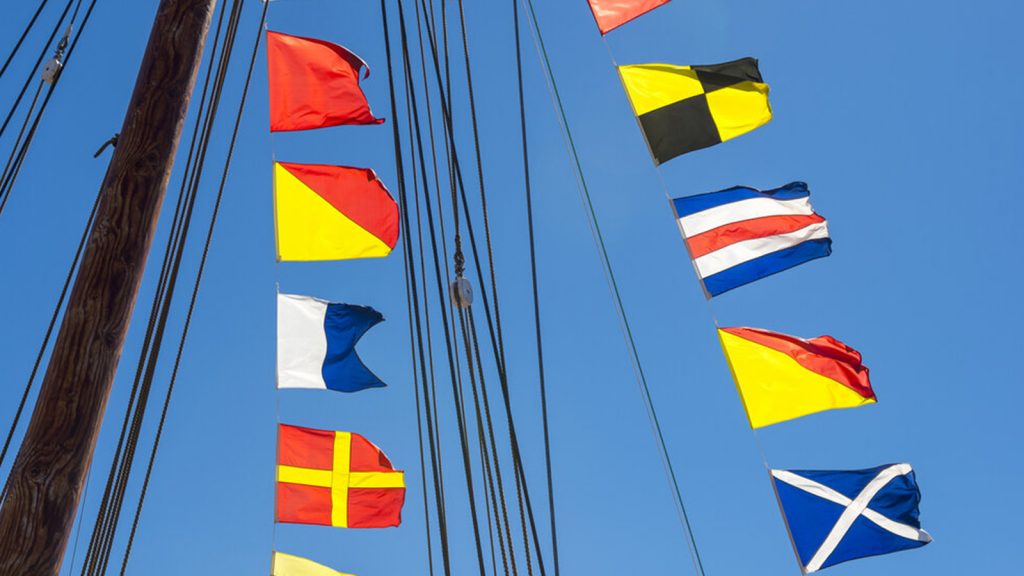
Nautical flags serve the purpose of communication in situations concerning navigation safety and individuals. They form an international code system enabling boats to signal to shore or for two boats to communicate with each other.
Individual flags have specific and standard meanings. These ones can be used in combination with another flag or alone. Using different nautical colored flags have a different meaning.
What are Nautical Flags?
Nautical flags, also known as maritime signal flags, are a set of flags and pennants used to communicate messages between ships and boats. Each flag represents a specific letter, number, or message, allowing vessels to convey information even when verbal communication is not possible.
The use of nautical flags dates back centuries and continues to be an essential aspect of seafaring traditions.
Nautical flags are compose of 26 square flags that represent the letters of the alphabet. There are also 10 numbered pendants, one answering pendant and three substitutes.
You will see nautical flags in a few colors because only a few flag colors are easily recognized:
Nautical Flags and Their Meanings
Importance of nautical flag meanings.
Understanding the meanings behind nautical flags is crucial for anyone involved in maritime activities.
Whether you’re a sailor, a boater, or simply fascinated by the sea, having knowledge of nautical flag communication enables you to interpret messages, navigate safely, and respond appropriately in different situations.
International Code of Signals
The International Code of Signals, also known as ICS, is a special set of rules that tells people who use nautical flags how to use them correctly. It helps sailors understand each other and communicate important messages by using these special flags in a specific way.
It was first established in the 19th century to facilitate communication and prevent misunderstandings among ships of different nationalities.
Over time, the code evolved and expanded to cover a wide range of messages and situations encountered at sea.
Within the International Code of Signals, each nautical flag represents a specific letter or number, as well as a set of predefined messages. These flags are combined to form words, phrases, and sentences, allowing vessels to spell out messages and communicate essential information.
The nautical flags in the International Code of Signals can be categorized into several groups, including alphabetic flags, numeric pennants, substitutes, repeaters, and special flags. Each category serves a specific purpose and carries distinct meanings when used in communication.
Individual Flag Meanings
Numeric pennants and their meanings.
Numeric pennants are a series of flags, each representing a number from zero to nine. These flags are used to communicate numerical information, such as coordinates, distances, or time. By combining different numeric pennants, vessels can convey precise numerical values, ensuring accurate communication between ships.
Letter flags and their meanings
Individual letters of the alphabet are represented by letter flags in the International Code of Signals. They are used to spell words and form sentences. Understanding the meanings assigned to each letter flag is critical for interpreting nautical flag messages and effectively communicating information.
Substitutes and repeaters in nautical flag communication
Substitute flags and repeater flags play important roles in nautical flag communication. Substitute flags are used to replace specific letter flags when they are not available or cannot be easily identified.
Repeater flags, on the other hand, are used to indicate that the preceding flag should be repeated. These flags ensure clarity and facilitate accurate transmission of messages.
Special flags and their purposes
The International Code of Signals includes several special flags that represent specific messages or commands. These flags convey information related to safety, medical assistance, maneuvering instructions, and more.
Understanding the meanings behind these special flags is crucial for maintaining safety and effective communication on the water.
Nautical Flags Meanings
It’s important to understand nautical flags and their meaning because they are valuable at sea in case of breakdowns in other communications systems (eg. radio) or in case of danger.
- One-flag signals are urgent or common signals.
- Two-flag signals are used for distress and maneuvering.
- Three-flag signals are for points of the compass, relative bearings, standard times, verbs, punctuation and also general code and decode signals.
- Four-flags are used mostly for geographical signals, names of ships, bearings, etc.
- Five-flag signals are used to relate time and position.
- Six-flag signals are used to indicate the main cardinal directions (N, S, E or W) in latitude and longitude signals.
- Seven-flags are used as signals for indicating longitude signals containing more than one hundred degrees.
Nautical flags are also used in nautical racing which signal to the competitors what they are supposed to do.
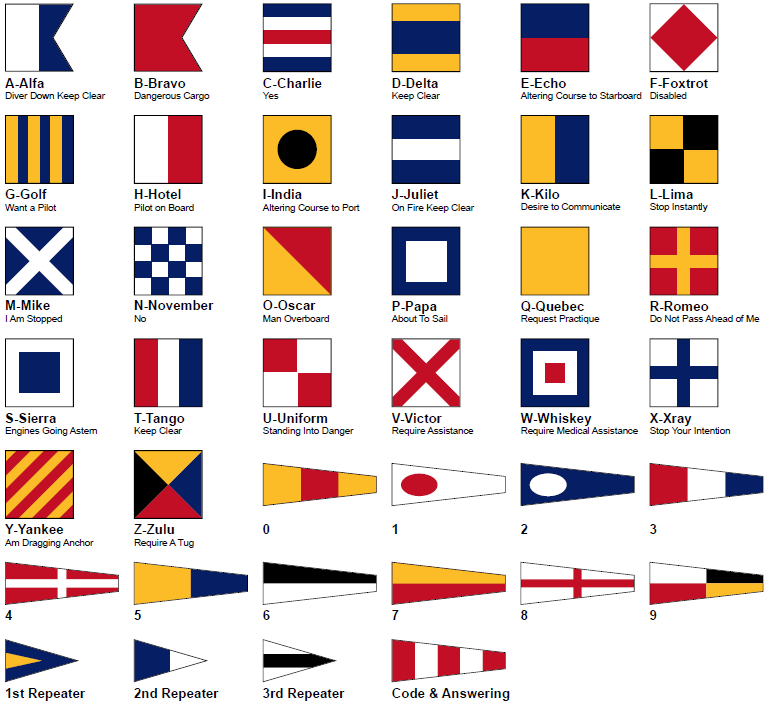
The Nautical Flag Alphabet
It is critical to understand that each flag representing a letter has a specific meaning.
International meanings for nautical flags:
- A: Alpha – diver down; I am undergoing a speed trial
- B: Bravo – carrying dangerous cargo
- C: Charlie – yes (affirmative)
- D: Delta – keep clear of me, I am manoevering with difficulty
- E: Echo – altering course to starboard
- F: Foxtrot – I am disabled, communicate with me
- G: Golf – I want a pilot
- H: Hotel – a pilot on board
- I: India – I am altering my course to port
- J: Juliet – vessel on fire keep clear
- K: Kilo – I want to communicate with you
- L: Lima – stop your vessel instantly, I have something important to communicate; Come Within Hail or Follow Me (Sailing Regatta)
- M: Mike – my vessel is stopped and making no way through the water; Mark Missing (Sailing Regatta)
- N: November – no (negative); Abandonment and Re-sail (Sailing Regatta)
- O: Oscar – Man overboard
- P: Papa – In port: All personnel return to ship; vessel is about to sail; At sea, fishing vessels might use this specific flag to convey the message “My nets have become entangled with an obstacle.”
- Q: Quebec – I request free pratique
- R: Romeo – reverse course
- S: Sierra – engines are going astern
- T: Tango – Keep clear; engaged in trawling. (International); Do not pass ahead of me. (Navy)
- U: Uniform – you are heading into danger
- V: Victor – require assistance
- W: Whiskey – require medical assistance
- X: X-ray – stop your intention
- Y: Yankee – am dragging anchor
- Z: Zulu – I require a tug

Solo or combined nautical flags have different meanings
Depending on the type of message, boats fly between 1 and 7 nautical flags. The combination of the O (Oscar) and W (Whiskey) flags, meanwhile, means “Man overboard. I require medical assistance”.
Signals with two nautical flags usually mean a certain problem of danger or maneuver. Three or more flags may include pendants and may indicate things such as compass points, time and position, geographic signals, geographic coordinates, and boat names.
Nautical Flags, sometimes the secret language of ships
While sailors around the world use nautical flags to communicate different scenarios, certain situations use secret language.
For example, the US Navy groups signals together in ways known only to its staff to communicate with its fellow ships.
NATO uses also the same nautical flags, with a few additional ones to warships, alone or in short sets to communicate various unclassified messages.
In yacht racing, the nautical flags have other meanings. These ones are solo or combined.
The P flag, for example, is employed as the “preparatory” flag to indicate an impending start, while the S flag indicates that a course has been shortened.
Nautical Flags to Buy
Interested in buying nautical flags to decorate your yacht? Whether you want to add a nautical flag pole, or you’re looking to replace an old nautical flag, we hope you find what you’re looking for!
Set of 50 Nautical Flags
We recommend this set of 50 (100% cotton) nautical flags. All flags are hand-made, so they can be quite smaller or bigger. Each flag is about 8 inches tall and 13 inches wide. All are printed on both sides. They give you a guarantee on color for life.
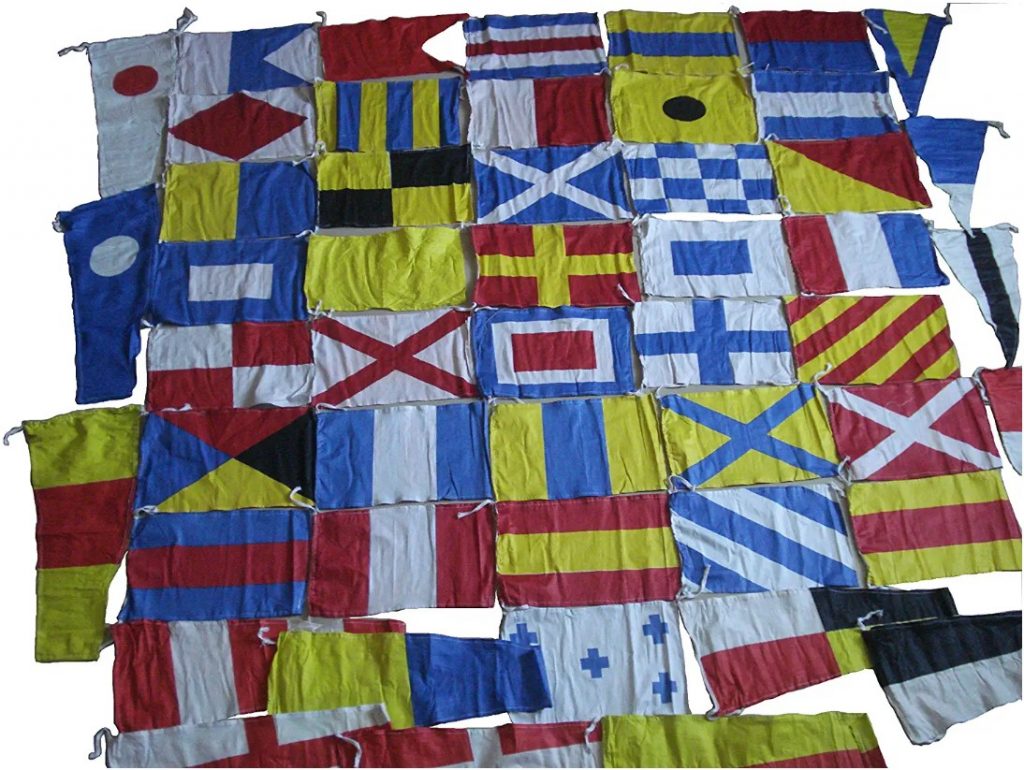
Maritime Signal Flags - 40 Different Decorative Flags - Over 40 Feet Long - Easy to Display
The flags are constructed of weather-resistant nylon cloth with double stitched seams. They are connected on a nylon chain with knots at both ends for convenient hanging.
These rectangular flags are 6″ x 9″, while pennant flags measure 6″ x 14″ or 6″ x 9″. The nylon cable is more than 40 feet long, with 7″ between flags and 36″ ties on either end.
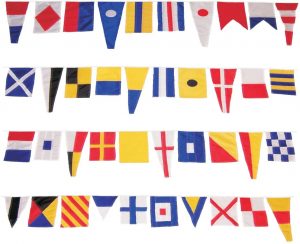
FLAGLINK International Marine Navy Signal Code Flag Set - String of 40 Flag - 40 Feet Long – Nautical Maritime Boat Ship Vessel Nautical Theme Decoration for Patry
Do you plan on throwing a big party on the boat and want to deck out the entire vessel in honor of the occasion? These nautical flags, which are less expensive than the previous ones, are an excellent choice for interior or outdoor decorations.
You may hang your ornamental flags in your front yard, garden, or patio, so that your family and friends can view the gorgeous holiday flag design from every aspect and vantage point. Because they are constructed of a water-resistant polyester fabric, they may be left outside for an extended period of time.
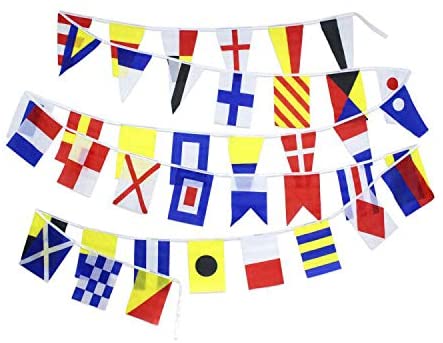
What nautical flags mean?
The purpose of nautical flags is to give ways and means of communication in circumstances involving the safety of navigation and people. Nautical flags are an international coding system used for a boat to indicate to land or for two vessels to signal to each other in situations involving the safety of navigation and people.
How many nautical flags are there?
There are 26 square nautical flags. Each of them symbolizes an international code term associated with the letters of the alphabet, such as Alpha, Bravo, Charlie, Delta, and so on.
What are nautical flags called?
Nautical flags are also known as international maritime signal flags, signal flags or boat flags.
How do you spell out messages using nautical flags?
Messages are spelled out using nautical flags by hoisting the flags in the correct sequence according to the International Code of Signals. Each flag represents a letter, and the combination of flags creates words, phrases, and sentences.
Are there any alternative systems to nautical flag communication?
While nautical flags are widely used for communication at sea, alternative systems such as radio communication, semaphore flags, and modern technologies like VHF radios and satellite communications also play a role in maritime communication.
Where can I learn more about nautical flag meanings?
To learn more about nautical flag meanings and communication, you can refer to resources such as official publications on the International Code of Signals, maritime museums, boating and sailing organizations, and online references that provide detailed information on nautical flags and their meanings.
Leave a Comment Cancel Reply
Your email address will not be published. Required fields are marked *
- – FlagMagic
- – Pirate Flags & History
- – Boat Flag Facts & Info
- – Pride Flags & History
- – Pride Month 2022
Boat Flag Color Meanings
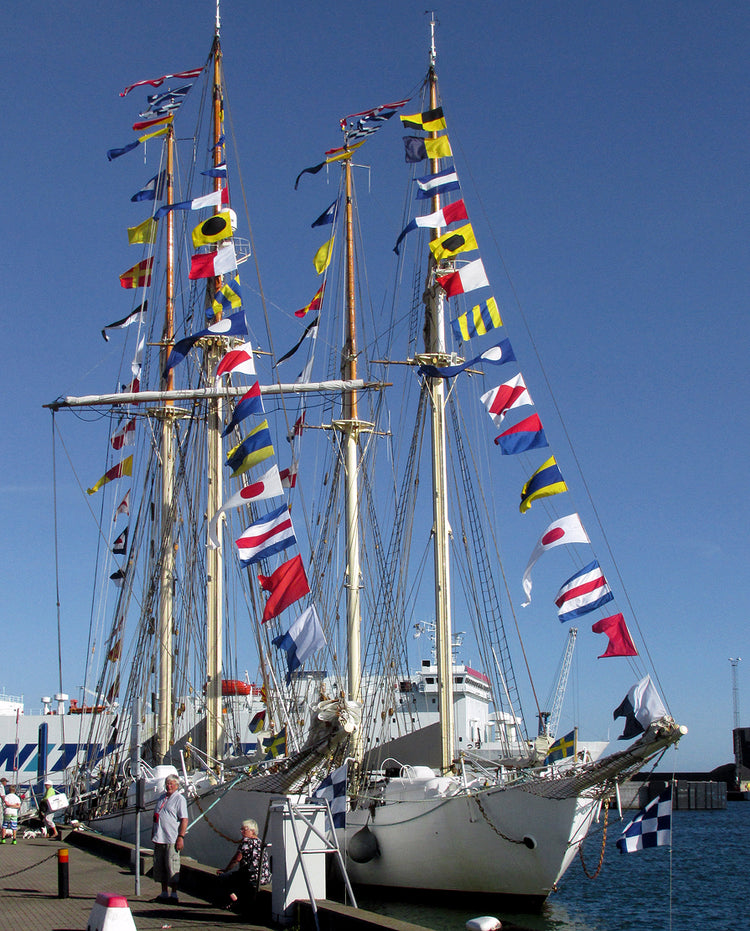
Boat Flag History
Boats have flown flags as a way of communicating across the water from the beginning. Colors designating origin and intent go back into prehistory. However, the modern way of signaling started in the 17th century. The Duke of York is credited with Modern naval code signaling starting with the Lord High Admiral after the Restoration.
To the untrained eye the flags have little meaning besides perhaps the country flags flown. This is not the case though, the colors have very specific meanings that can be seen below.
Once you have learned about what colors mean, check out our collection of boat flags here!
Signal Flags
Signal flags are known as the International Code of Signals.
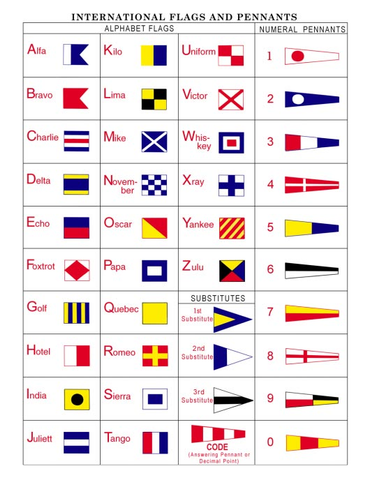
Alfa: Diver Down/Keep clear
Bravo: Dangerous cargo
Charlie: Yes/Affirmative
Delta: Keep clear
Echo: Altering course to starboard
Foxtrot: Disabled
Golf: I need a pilot or I am hauling nets
Hotel: I have a pilot on board
India: Altering course to port
Juliet: On fire
Kilo: I would like to communicate with you
Lima: Stop now
Mike: I am stopped and not making headway
November: No/Negative
Oscar: Man overboard
Papa: Report on board, vessel is about to sail
Quebec: Vessel is healthy, request clearance into port (for international entrance)
Romeo: Do not pass ahead of me
Sierra: Engine going astern
Tango: Keep clear
Uniform: You are running into danger
Victor: I need assistance
Whiskey: I need medical assistance
Xray: Stop and watch for my signal
Yankee: Dragging my anchor
Zulu: I need a tug
Popular Boat Flag Color Questions
Question: What are the colors of nautical flags?
Answer: You can use all colors on nautical flags. There are different kinds of nautical flags with different requirements. For signal flags, white, red, yellow, black, and blue are the only colors allowed.
Question: What d oes a black and yellow flag mean on a boat?
Answer: A black and yellow squares flag is "Lima." In days past it was meant to signal a quarantine with a dangerous infectious disease on board. That standard was abolished in 1965. Now it simply means "you should stop your vessel immediately." Some people may still adhere to the old standard. In either case, you should avoid any ship flying a black and yellow squares flag.
Question: What does a black flag mean on a ship?
Answer: In years past a black flag was flown by pirates. It showed intent to board a vessel and take valuables. If the boarded vessel did not fight back the crew would be spared. You can create your own black pirate flag here! This is in contrast to the red flag which meant no quarter would be given. These days, the black flag is mainly used in sailing races. If a black flag is raised the vessel has been disqualified from the race.
Question: What does a Blue Flag mean on a boat?
Answer: Blue and white means a diver is in the water. Blue not on signal flags shows a regard for the environment. You could create your own custom blue boating flag the show your support of the environment here.
Question: What does a red flag mean on a boat?
Answer: Red is generally a signal of danger. A red flag with black square signals a hurricane or storm. In the Golden Age of Piracy it was a sign that no quarter will be given.
Question: What does a solid orange flag mean?
Answer: In the United States, boats towing people are required to carry a solid orange flag. The flag will be raised with the water skier, tuber, or person otherwise being towed is down and in the water.
Question: What does a white and blue flag mean for boating?
Answer: A white and blue flag is most commonly "Alpha." It signals there is a diver in the water and that other vessels should stay away and steer clear.
Question: What does a white flag mean on a boat?
Answer: A white flag designates a private or dangerous area. It signals "Do not enter, touch, or use."
Question: What does a yellow flag on a yacht mean?
Answer: The yellow flag is "Q" and it signals that there is no disease on board the vessel.
Custom Flag Designers Online
We're creating new, high quality custom flag designers online every day

U.S Navy Commissions USS New Jersey, First Ever Submarine For A Mixed Gender Crew

World’s Largest Hotel-Branded Superyacht Sets Sail For Maiden Voyage

India Establishes Its First Maritime Arbitration Center

Yanmar Unveils Its First Electric Propulsion Product For Emission-Free Sailing

Understanding Nautical Flag Etiquettes
From the time that ships started sailing, flags were in place as a mode of communication or expression of intent. Traditionally speaking, flags have always formed an integral part of shipping but the necessity and extent of usage have obviously reduced over time owing to advancements in technology.
However, much like other so-called ‘arts’ pertaining to the shipping industry, flag etiquette have stood the test of time and if not extensively, flags are still displayed when absolutely important (e.g, entering a port). The order of importance, points and honour of the flags have long been established and are a tradition albeit with new designs and meaning in some cases.
Definitions
Flag related terms are of the old school and may cause some difficulty for candidates appearing for competitive examination! While the INTERCO meaning of single letter flags is easily grasped, the terminology is something that requires basic understanding.
- Canton: This refers to any quadrant of a flag but mostly, the upper left quarter (one that is hoisted)
- Hoist: The edge of the flag nearest to the flagpole
- Fly: The edge farthest away from the flagpole
- Courtesy Flag: The national flag or the civil ensign of the country you are visiting
- Dimension: Varies, but usually the fly is twice as long as the hoist
- National Ensign: The flag of the country your ship is registered to
- House Flag: Usually, the company flag
- Tack Line: Length of halyard about 2 metres used to separate group of flags
- Halyard: Ropes used for hoisting flags
- Pigeon Hole: Flag locker hole
- Close Up: Flags fully hoisted
- Dip: Not to be confused with the dip of a sextant! Dip means that an upright flag is lowered to 45 degrees or horizontal. This is done as a sign of respect
Worn and Flown
There is some confusion with regard to this (much like underway and making way!)- vessels wear flags; people fly flags on their vessels. Each flag has a specific meaning along with the appropriate location for it to be worn and the time that it can be flown. Next up will be the order of the points of honour signifying the order of preference, i.e., the highest in the points of honour will fly the most important flag (which is basically your own ensign)
How to Read Flags
- Mast – Top to Bottom
- Triatic Stay – Forward to Aft (stay connecting mastheads is termed Triatic Stay)
- Starboard Yardarm – Outer to inner
- Port Yardarm – Outer to inner
Order (Points Of Honour)
In order of preference:
- Flagstaff at the stern
- Starboard Yardarm
- Port Yardarm
Fly the flag at the highest point of honour to which that particular flag is entitled. The highest place is always given to your own national ensign. All other flags must be placed below.
[the_ad id=’172861′]
The National Ensign
The gaff holds the highest importance. Second to that is the stern flagstaff (more common for the ensign in modern merchant vessels). So there might be a confusion with regard to ‘height’ being a factor seeing as the stern staff is much lower; although another flag might appear higher, no flag is ever flown above the national ensign on the same halyard. Gaff is used for holding the ensign flag when the ship is underway. Ensign on the gaff and Jack on the jack staff do not go together
Jack is to be hoisted only when the ship is at anchor or made fast to the shore or to a buoy. The jack is lowered immediately when the ship is underway, when the anchor is aweigh or the last line is cast off
Red Ensign Worn by a merchant vessel
White Ensign Worn by warships/naval establishments
Blue Ensign Worn by ships belonging to public offices
Instances when Ensign is flown
- When the ship is dressed
- In foreign waters during daylight hours
- When going alongside foreign port, man of war, day or night
The Courtesy Flag
It is a custom among merchant ships when entering or leaving a foreign port and during their stay in the port to fly the colours of that country. as a mark of respect; the exact details of flying such a flag with regard to timings can be obtained from the port control. The dimensions of the national ensign must always be larger than the courtesy. Also, never fly one country’s flag beneath another’s on the same mast. This is a sign of conquest and projects disrespect, ignorance and bad seamanship. Also, do not hoist the courtesy flag upside down. As mentioned, follow the port country’s rules with respect to the courtesy; some countries might have a rule wherein to fly the courtesy only after the Q (quarantine) flag has been secured. The courtesy flag comes second in order of preference after the national ensign.
As per INTERCO, the Q flag denotes “My vessel is healthy. I require free pratique”. It is a flag that is hoisted inevitably by all vessels prior to entering the port to denote that the vessel is healthy and disease free and requests clearance. Preferably, fly it on the starboard yardarm and take it down after the vessel has been cleared by the health authorities of that country.
The national ensign or the courtesy should not be flown from sunset to 0800 hours unless specifically mentioned to do so (Mexico requires their flag to be flown after sunset as well). At 0800 when raising the flags, the national ensign should be raised first followed by the courtesy and the rest. The reverse order is applicable during lowering.
Blue Peter
Commonly flown by merchant ships to denote that the ship is about to sail and that all crew who may be out of the ship to return back to the ship immediately.
Half Mast
The concept of half mast is to denote respect. Flags are flown at half mast when saluting another vessel (naval vessels of war). The Naval ship reciprocates by lowering and raising their national ensign after which the own ensign is returned to full hoist.
Also, the Ensign is worn at half mast to indicate death. Usually on the day of the funeral only and from the time the body of the deceased leaves the ship or place where it has been lying until the time when it is buried
Dressing The Ship
On special occasions such as Republic Day, Independence Day and the likes, ships or other vessels may dress their ships in full regal splendour. This includes displaying a set of 40 flags representing numbers, letters and other signals. A vessel is dressed only while not underway. This might also be done for a special time such as her maiden or final voyage.
INTERCO refers to the International Code of Signals. It is an international system of signals and codes for use by vessels to communicate important messages regarding safety of navigation and related matters. Signals can be sent by flag hoist, ALDIS lamp, semaphore, radiotelegraphy, and radiotelephony. To make sense of the above, it is important to know the INTERCO (at least the single letters) for the purpose of the oral examinations as well as a matter of interest as a sailor. It contains 14 chapters, complement tables for the general section, complement tables for the medical section appendices. This code provides a means of communication seeing as there might be language difficulties among stations which affect the safety of the ship and the personnel. INTERCO contains single letter signals (A to Z) which are urgent, important and of very common use; two letter signals (AA to ZZ) for vocabulary; three letter signals (MAA-MVU) containing medical signals.
The single letter signals are used regularly and meanings of all must be known. They’re used in COLREGS (flags for vessels engaged in fishing have a separate Annex attached to it namely flags Z, G, P, T) as well as for emergency situations where communication might be urgent such as man overboard (O), when dragging anchor or when another vessel is dragging anchor onto the own ship etc. Two letter signals also have immense importance as with the NC flag (Distress flag as per Annex 4 of COLREGS) and YG (for TSS).
Code and Answering Pendant
3 red and 2 white stripe vertically placed at hoist and at fly. Various uses of answering pendants by hoisting are:
- At Dip- Signal is seen
- Close Up: Signal is understood
- Haul down/return to dip after close up- signal is received
Substitutes
1st Substitute- yellow triangle with blue border
2nd Substitute- Blue and white. Blue at hoist, white at fly
3rd Substitute- White with black horizontal stripe
Examination Service
In certain circumstances, it is necessary to take special measures to examine ship’s desire to enter a port and to control the entry. Generally, it is enforced when the security of the port is threatened or expected to be threatened. Examination vessel flag is a blue rectangular flag with two rectangles in the centre. Vessels authorised to display the examination flags are examination vessel, traffic control vessel and pilot launch when assigned to examination duty
Flags when entering a port
This has become a common question across Indian MMDs for the Second Mate oral examinations and therefore included in the article.
- Flag G or H (depending on whether pilot is yet to board or already boarded)- Port Yardarm
- The National Ensign (stern post)
- The Courtesy Flag (Starboard Yardarm)
- Flag B (if carrying IMDG cargo)- Port Yardarm
- House Flag- Port Yardarm
These are age old techniques and are here to stay. There is far too much information with respect to flags which cannot be covered under one article and it is advised to go through the INTERCO publication for a better understanding.
With the reasons for hoisting a certain flag at a certain point on the ship made easier and comprehensible, the next time a flag is hoisted should seem more interesting.

About Author
Shilavadra Bhattacharjee is a shipbroker with a background in commercial operations after having sailed onboard as a Third Officer. His interests primarily lie in the energy sector, books and travelling.
Read More Articles By This Author >
Disclaimer : The information contained in this website is for general information purposes only. While we endeavour to keep the information up to date and correct, we make no representations or warranties of any kind, express or implied, about the completeness, accuracy, reliability, suitability or availability with respect to the website or the information, products, services, or related graphics contained on the website for any purpose. Any reliance you place on such information is therefore strictly at your own risk.
In no event will we be liable for any loss or damage including without limitation, indirect or consequential loss or damage, or any loss or damage whatsoever arising from loss of data or profits arising out of, or in connection with, the use of this website.

Do you have info to share with us ? Suggest a correction
Daily Maritime News, Straight To Your Inbox
Sign Up To Get Daily Newsletters
Join over 60k+ people who read our daily newsletters
By subscribing, you agree to our Privacy Policy and may receive occasional deal communications; you can unsubscribe anytime.

BE THE FIRST TO COMMENT
Thanks for all the detailed information about flags!
You mentioned there is a difference between “underway” and “making way.” Would you mind explaining what it is?
Thank you again for the article. I’ve bookmarked it for future reference.
cool i loved it
Great article. But why can’t you fly the ensign and the Jack at the same time? So when the Jack is hoisted, you have to lower the ensign? Thanks for answear.
Good article, I would like permission to use extracts from your article in our sailing club newsletter. I feel that the flag protocols and traditions are not fully understood or even followed.
@Deon: You are allowed to do so after giving proper credit to the author and https://www.marineinsight.com
Underway is when a vessel is free floating in the water (I.e. not at anchor or moored at a pier). Making way is when a vessel is moving through the water under power or sail and being navigated via it’s rudder.
Thank you for the comment Captain GB
How do you make full dressing of merchant tanker?
Leave a Reply
Your email address will not be published. Required fields are marked *
Subscribe to Marine Insight Daily Newsletter
" * " indicates required fields
Marine Engineering
Marine Engine Air Compressor Marine Boiler Oily Water Separator Marine Electrical Ship Generator Ship Stabilizer
Nautical Science
Mooring Bridge Watchkeeping Ship Manoeuvring Nautical Charts Anchoring Nautical Equipment Shipboard Guidelines
Explore
Free Maritime eBooks Premium Maritime eBooks Marine Safety Financial Planning Marine Careers Maritime Law Ship Dry Dock
Shipping News Maritime Reports Videos Maritime Piracy Offshore Safety Of Life At Sea (SOLAS) MARPOL
WAIT! Did You Download 13 FREE Maritime eBooks?
Sign-up and download instantly!
We respect your privacy and take protecting it very seriously. No spam!

- AMERICA'S CUP
- CLASSIFIEDS
- NEWSLETTERS
- SUBMIT NEWS
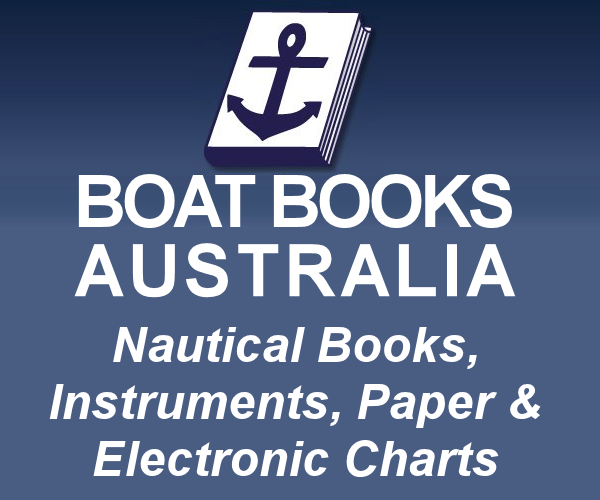
Flag Etiquette on a sailing boat today
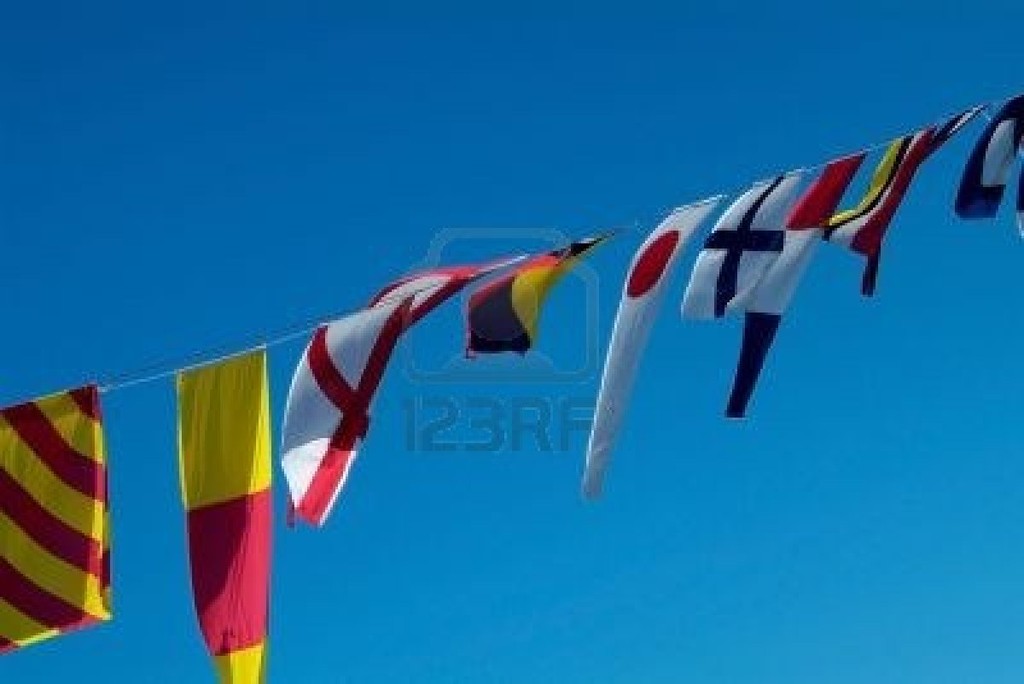
Related Articles
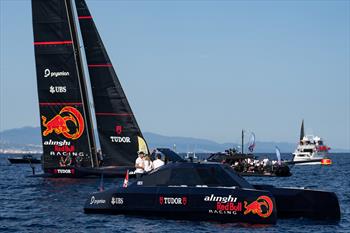

IMAGES
VIDEO
COMMENTS
For the numbers 10 and larger, a boat would combine flags. 3. Colors are by choice. The only colors you'll find on nautical flags are black, blue, red, yellow, and white. These colors stand out quite well when seen with your own eyes on the horizon or through binoculars. Flags can be a solid color or a combination of colors, too. 4.
W - Whiskey - I require medical assistance. X - X-ray - stop your intention. Y - Yankee - I am dragging anchor. Z - Zulu - I require a tug. 3. Remember that the numbers on nautical flags have meanings, too. When it comes to numbers, boaters use pendants. Ten different pendants represent the numbers zero through nine.
Calling the O Flag the cheating flag is certainly a bit of a misnomer. The O Flag does, however, suspend Rule 42 of the Racing Rules of Sailing. Rule 42 is particularly notorious, as it bans pumping, rocking, ooching, sculling, and excessive maneuvering, all of which are methods to make your boat go substantially faster.
Blue Flag: This flag indicates that a boat intends to protest another boat for breaking a rule. It's important to keep a close eye on this flag, as it signifies a potential dispute between competitors. Yellow Flag: When this flag is displayed, it means that a protest hearing is being held. This flag warns all par ...
Nautical flag etiquette is an essential part of sailing. The seven most common types of boat flags are Skin Diver flags, Storm Warning flags, Coast Guard boat flags, US Jack flags, Maritime flags and Pennants, Yacht Ensign & Officer flags, and most importantly the International Code Signal flags. Code signal flags and are frequently used by ...
For the numbers 10 and larger, a boat would combine flags. 3. Colors are by choice. The only colors you'll find on nautical flags are black, blue, red, yellow, and white. These colors stand out quite well when seen with your own eyes on the horizon or through binoculars. Flags can be a solid color or a combination of colors, too. 4.
Nautical Flags and Their Meanings. The purpose of the International Code of Signals is to provide ways and means of communication in situations related essentially to safety of navigation and persons, especially when language difficulties arise, or because radio silence is required. Here are their names and meanings, both International and/or ...
If your boat is named Zorro, don't raise the "Z" flag alone, or you may suddenly be popular. One signal to know and not use unless you're serious is the distress signal. This signal is composed of the "N" and "C" flags, with the "N" on top. The "N" carries a blue-and-white check pattern, while the "C" flag has blue ...
In emergencies, flags like the Oscar Flag, which is orange and yellow, or the Papa flag, designed in blue and white, signal the need for immediate help. 2. Communication Between Ships Using nautical flags for communication between ships is highly efficient and reliable. However, there can be unavailability or poor visibility of a specific flag.
The blue flag is displayed by a boat in distress or requiring assistance, and other boats must immediately make way for the distressed boat. If a boat fails to acknowledge the blue flag signal, it may be subject to penalties. The Red Flag Rule. The red flag rule is used to signal that a race has been stopped due to an emergency situation. The ...
A rectangular blue flag with 50 stars-the upper quadrant of the National Ensign nearest the hoist, properly referred to as a canton. ... On a sailboat, the courtesy flag is flown at the boat's starboard spreader, whether the United States ensign is at the stern staff, or flown from the leech. ...
Sailboat flag etiquette is a combination of law and maritime tradition. It is a way of showing respect, courtesy and recognition to other vessels, countries and organizations. ... Some British sailboats fly a white or blue ensign because they belong to certain yacht clubs or organisations that have special permission to use these ensigns.
International Nautical Flag Meanings. Each flag representing a letter of the alphabet has a meaning. The meanings are as follows: A or Alpha - keep clear, diver down. B or Bravo - carrying dangerous cargo. C or Charlie - yes. D or Delta - keep clear. E or Echo - altering course to starboard. F or Foxtrot - I am disabled.
Because of their dual nature, nautical flags can be hung individually or strung together to send more complex messages. For instance, the delta or "d" flag means "I am maneuvering with difficulty, keep clear.". The victor or "v" flag means "I require assistance.". People who can spot the "d" and "v" flags on sight—a ...
Nautical flags are part of an international code signaling system. These flags represent letters of the alphabet, numbers, and other signals, and they come in vibrant colors like red, blue, yellow, black, and white for maximum visibility. The combinations of these colors were carefully chosen to be easily distinguishable from afar.
Yacht flags, in particular, are used to signal the boat's identity, status, or intention. For example, a yellow and blue flag with a white anchor in the center is a signal for a vessel that is at anchor. A white flag with a blue square and a white cross in the center signals that the boat is a medical vessel or has a medical emergency on board.
Nautical flags, also known as maritime signal flags, are a set of flags and pennants used to communicate messages between ships and boats. Each flag represents a specific letter, number, or message, allowing vessels to convey information even when verbal communication is not possible. The use of nautical flags dates back centuries and continues ...
Two sailing ships dressed overall with their signal flags. International maritime signal flags are various flags used to communicate with ships. The principal system of flags and associated codes is the International Code of Signals. [1] Various navies have flag systems with additional flags and codes, and other flags are used in special uses, or have historical significance.
Marine Electronics. Dive into the sea of maritime communication with our Ultimate Guide to Nautical Flags. Decode meanings, understand signals and navigate the waves confidently.
Boat Flag History. Boats have flown flags as a way of communicating across the water from the beginning. Colors designating origin and intent go back into prehistory. However, the modern way of signaling started in the 17th century. ... Question: What does a Blue Flag mean on a boat? Answer: Blue and white means a diver is in the water. Blue ...
For power boats, all other flags should be 5/8″ long for each foot of overall length. A 56-foot boat should have a 35-inch long flag. Proper boat flag size varies depending on the size of the boat in question. Semaphore flags (discussed below) are always made as an 18″ x 18″ square.
Examination vessel flag is a blue rectangular flag with two rectangles in the centre. Vessels authorised to display the examination flags are examination vessel, traffic control vessel and pilot launch when assigned to examination duty ... Making way is when a vessel is moving through the water under power or sail and being navigated via it's ...
Other flags, such as club burgees, private signals and courtesy flags used on sailboats should be approximately 1/2 inch for each foot of the highest mast above the water. For example, on a 30ft. boat, with 50ft. between the masthead and the water, the burgee should be about 25 in. The shape and proportions of pennants and burgees will be ...